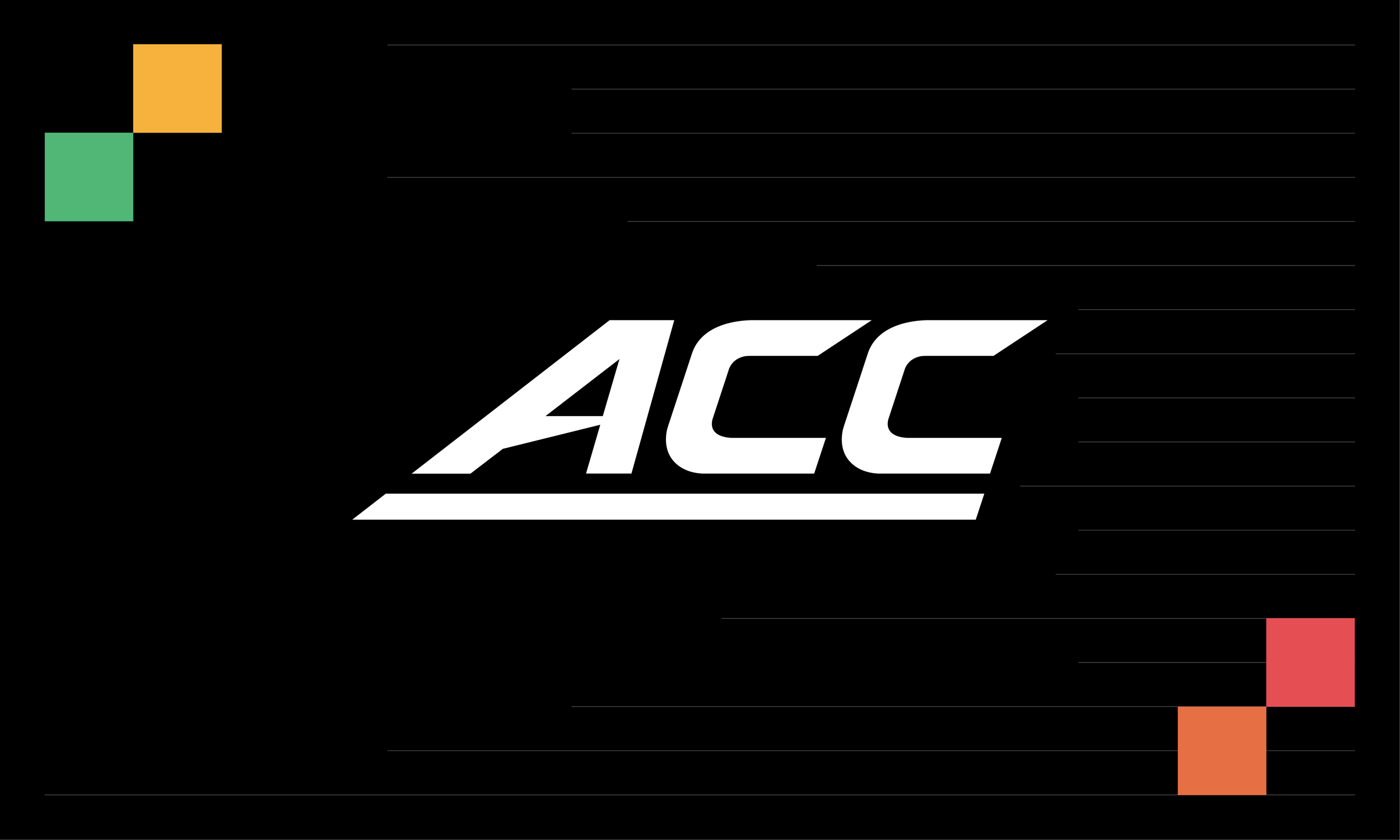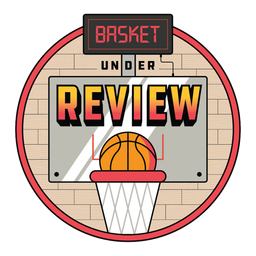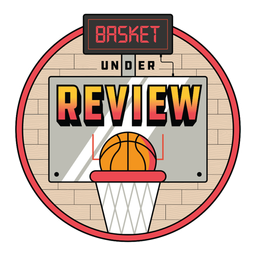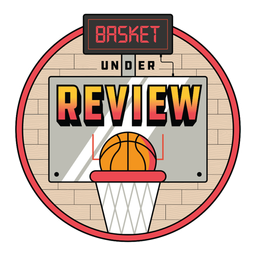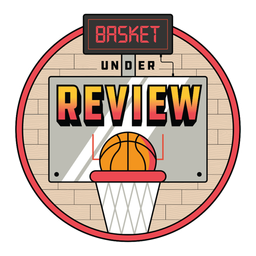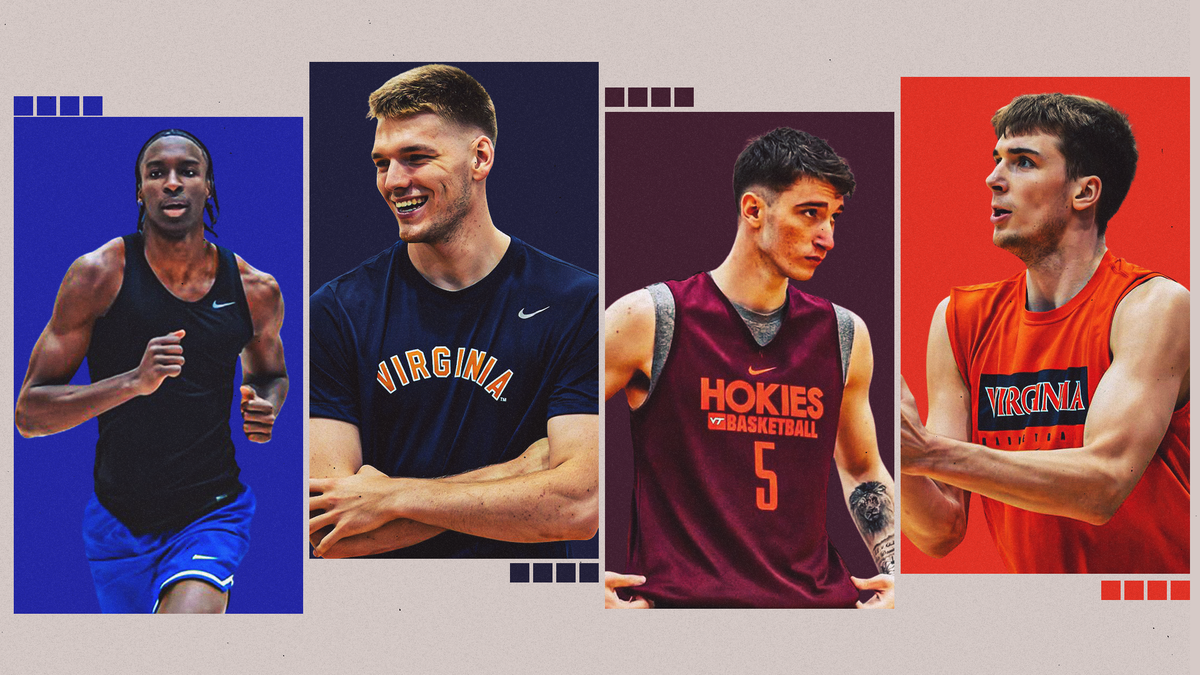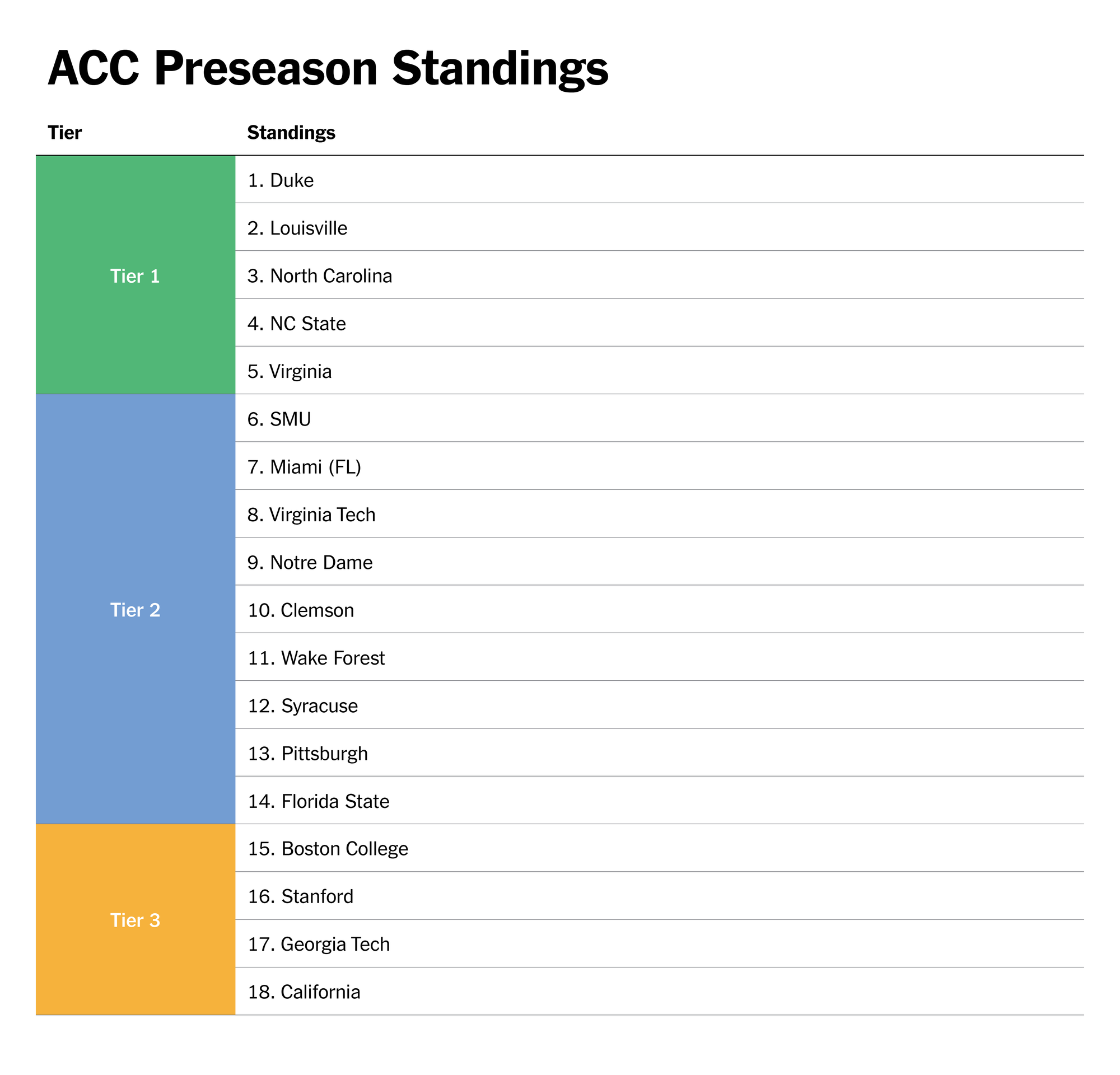
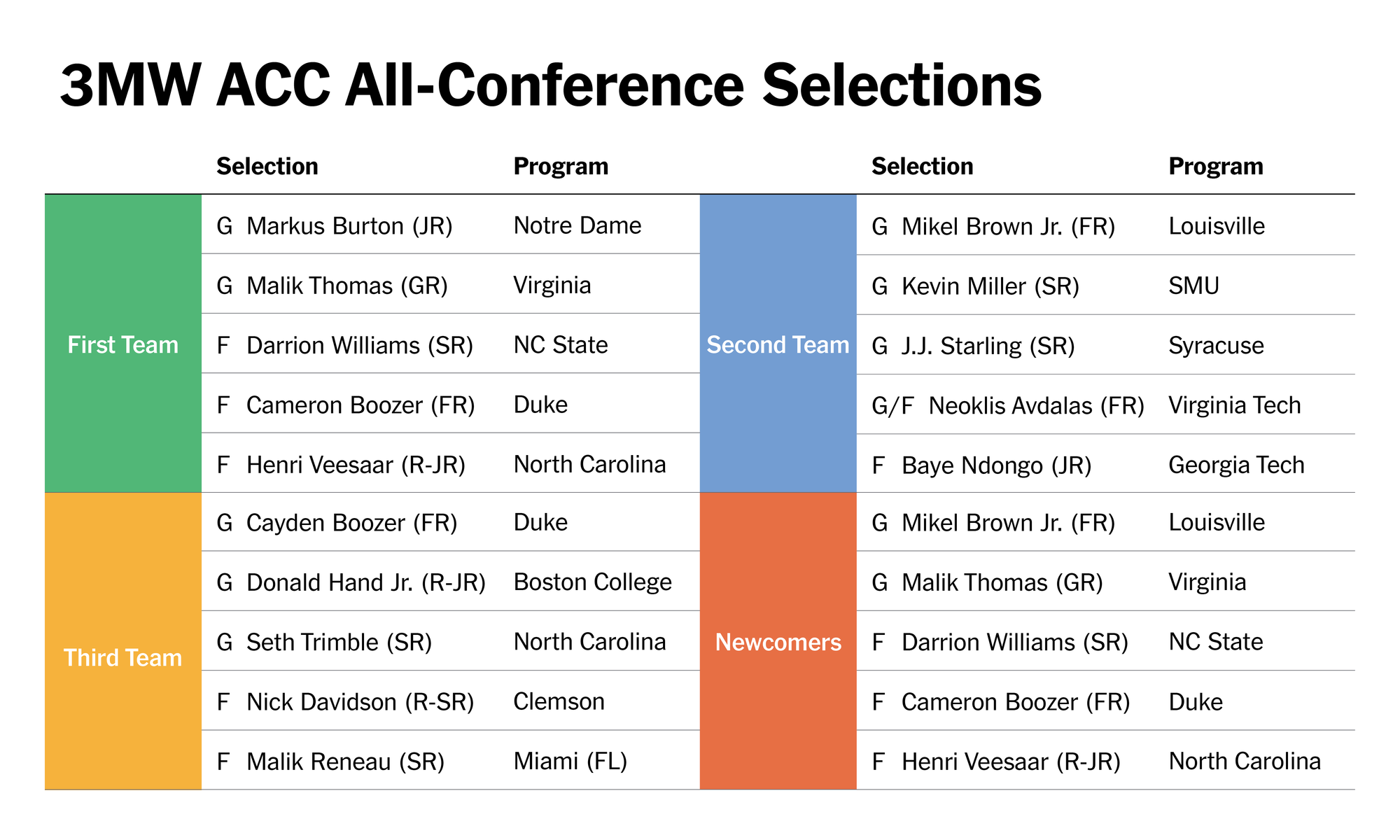
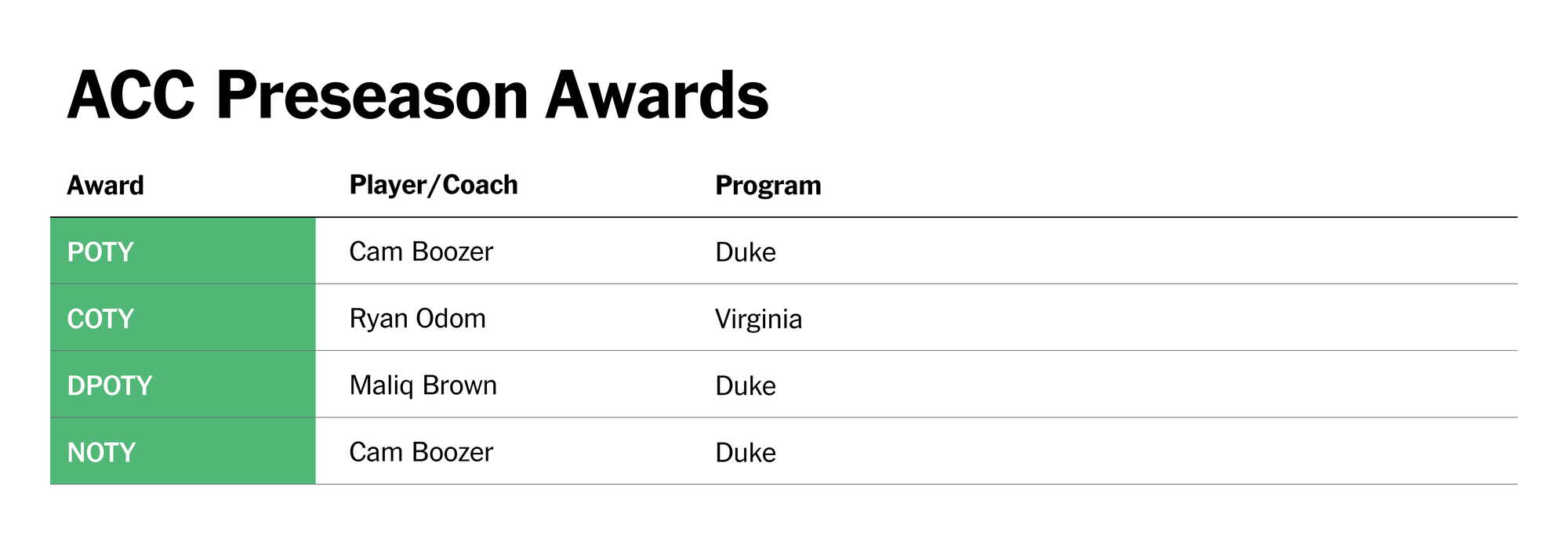
***Team previews previously released in our top-50 countdown can be accessed by clicking on the team below. Note that top-50 rankings and conference rankings may not always align - the top-50 rankings are an aggregate ranking while the conference rankings are the sole discretion of the writer.
1) Duke
2) Louisville
3) North Carolina
4) NC State
5) Virginia
6) SMU
7) Miami FL
8) Virginia Tech
Key Returners:
Jaden Schutt, Toibu Lawal, Tyler Johnson, Ben Hammond
Key Losses:
Jaydon Young, Ben Burnham, Mylyjael Poteat
Key Newcomers:
Neoklis Avdalas, Izaiah Pasha,, Amani Hansberry, Jailen Bedford
Roster:
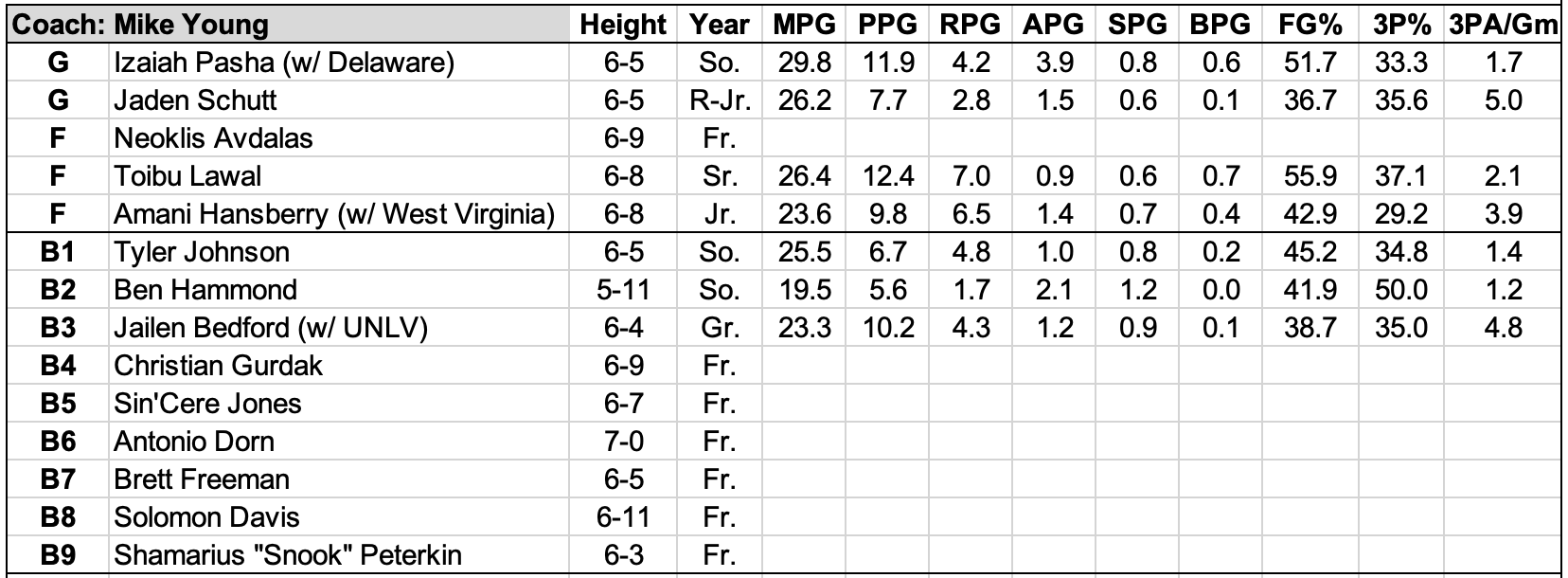
Reasons for Optimism:
Is Neo the one?
Meet Neoklis Avdalas, one of the most anticipated international prospects set to debut this season in college basketball. Had Neo opted to turn pro last cycle, he would’ve likely been a first round draft pick. In a nutshell, Mike Young hasn’t had this caliber of talent in a while, maybe ever?
The beauty in Avdalas’ game is his offensive versatility. He’s a true queen on the chessboard type weapon, capable of bringing the ball up as a point forward or playing off the ball as a wing or small ball 4. That type of optionality in today’s portal era is precious, since no coach can precisely predict how the pieces will fall in place.
Young inked a true point guard in the portal, Izaiah Pasha, who walks into one of the best point guard cockpits in the entire ACC. Flanked by Neo and multiple shooters, and supported by a wildly athletic and versatile frontline, Pasha’s support system sets him up for immediate success this year. At 6-4, Pasha is a microcosm of the serious upgrades Young made in the positional length department this offseason.
Up front, Tobi Lawal is back for another bite at the apple in hopes of “not being that bad” this year (and hopefully better than ‘ass’). His freakish leaping ability wasn’t enough to lift this team out of the gutter last year but next to Amani Hansberry, the Hokies’ interior unit suddenly looks formidable. Hansberry partly resembles my personal favorite Mike Young-coached big of all time, Cameron Young at Wofford, an elite offensive ‘connector’. Young sees a similar use case in Hansberry on the offensive end this year.
“We talk about our connector, an offensive connector, which is very important. If that connector is your 5, it's hard to switch with 5 onto a guard. When your connector is your 5, that lends itself to some things offensively that can be really hard to guard. We're just getting into it, the nuts and bolts of it but we’ve covered it throughout the summer.”
Squint hard enough and envision the potential of Hansberry-initiated handoffs or setup screens at the top of the key with Neo flying off them.
The floor spacing should be upheld by a solid supporting cast, who masquerated as go-to guys on last year’s talent poor team. Jaden Schutt is the best of the bunch but Tyler Johnson and Ben Hammond will be woven in as well. Young also added a microwave supersub in Jailen Bedford, who can get buckets in bunches off the pine. Bedford led the entire Mountain West in shot usage rate last year, so Young would be wise to cap his minutes and prevent him from hijacking the offensive flow. However, his scoring outbursts could be life savers during any offensive droughts. As a bonus, Bedford is a legitimate defender on the other end as well (Young considers him his best on ball defender).
It’s easy to gloss over the fact that Young inked two other 4-star prospects. Suddenly this bench looks miles longer than Young’s recent teams. Christian Gurdak and Sincere Jones could be called into action immediately, especially Gurdak, whose 7-2 wingspan could vault him into contention for minutes at the 5 right away. He’s not a pogo stick leaper but he can man the middle in spurts, especially against jumbo sized opponents looking to attack Hansberry and Lawal at the 5. Additional reserves at Young’s disposal are 7-foot German import Antonio Dorn and DeMatha product Solomon Davis. Add it all up and there’s at least 10 potential rotational pieces to build out this rotation.
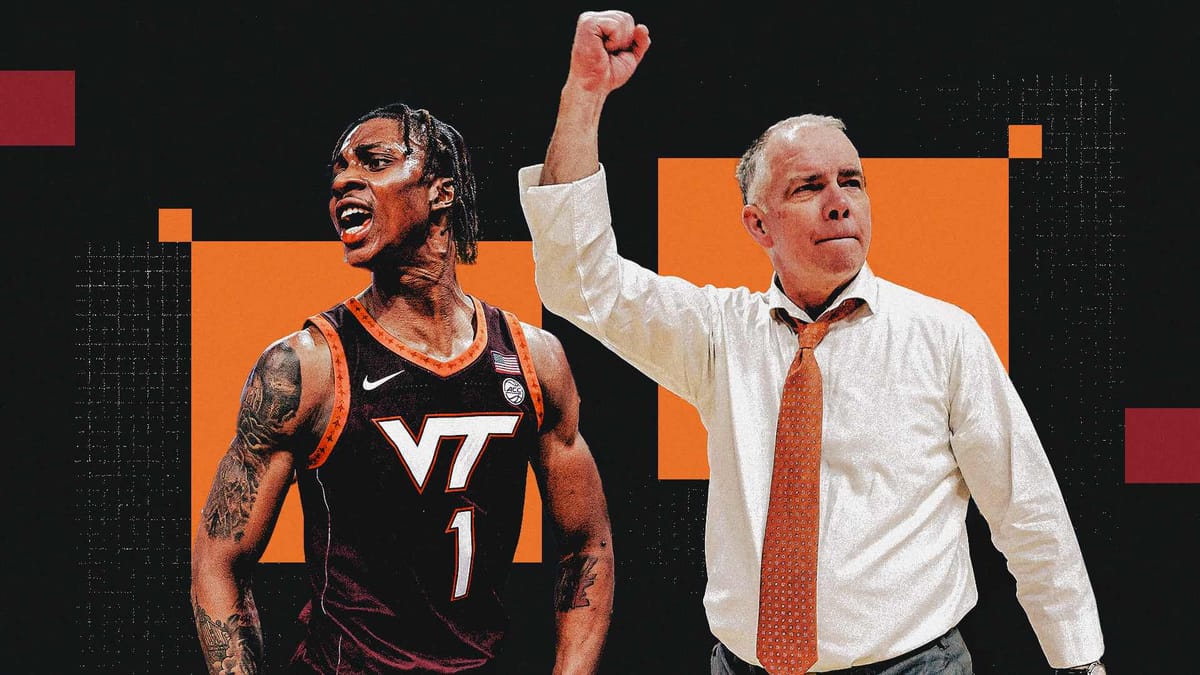
Causes for Concern:
Young’s adaptation to the new player recruitment landscape is admirable but he will never abandon his precious internal player development pride - an admirable trait, but one that’s been a negative EV strategy with retention problems in prior years.
This year’s bench, as mentioned above, is likely a strength but this team still sits on the younger end of the spectrum, at least by today’s college standards.
The other risk with leaning heavily on Neo is his delayed integration with the offseason practice program. While he gained invaluable experience playing in the U-20s overseas, Young would’ve probably prefer have him in the mix sooner rather than later, which he hinted at when asked during the summer media check in.
“What are your impressions now that everyone is here? How do the pieces fit?”
“Work in progress. It was a tad choppy as Neo was playing for his national team in the under-20 world games in Greece, as a matter of fact. We knew that we weren't going to get him here before the third week of July, maybe even the last week of July. We probably practiced with Neo and the whole unit for 10 to 12 practices late summer, which was a big deal.”
Finally, for all the focus on positional size and length, Young recognizes that tradeoff may come at the expense of outside shooting, a calling card of Young’s teams in prior seasons. I think he’s being a little harsh since his bar is higher than most coaches.
“I've done it throughout my career with a number of guys that could really shoot it. We shoot the ball well. I don't think it's going to be an Achilles heel but we don't knock the bottom out of it like some teams that I've had. I said the other day we're going to have some games when we make 12. We're going to have some games we make six. But defensively and in other areas, we're going to be much improved.”
Bottom Line:
Props to the VT collectives for getting their NIL ducks in a row and arming Mike Young with the roster he deserves. Additional props to Young for addressing a few of his historical weaknesses in terms of roster construction. This roster meets the minimum requirement in terms of talent, length and athleticism to compete in the upper half of the ACC, a far cry from last season’s baseline.
The key will be Neo, and how he transitions into Young’s system - or, vice versa. Young might be best served letting the future pro organically grow into the best version of his self, and then move the other chess pieces around him.
9) Notre Dame
Key Returners:
Markus Burton, Braeden Shrewsberry, Kebba Njie, Sir Mohammed
Key Losses:
Tae Davis, Matt Allocco
Key Newcomers:
Jalen Haralson, Carson Towt, Ryder Frost
Roster:
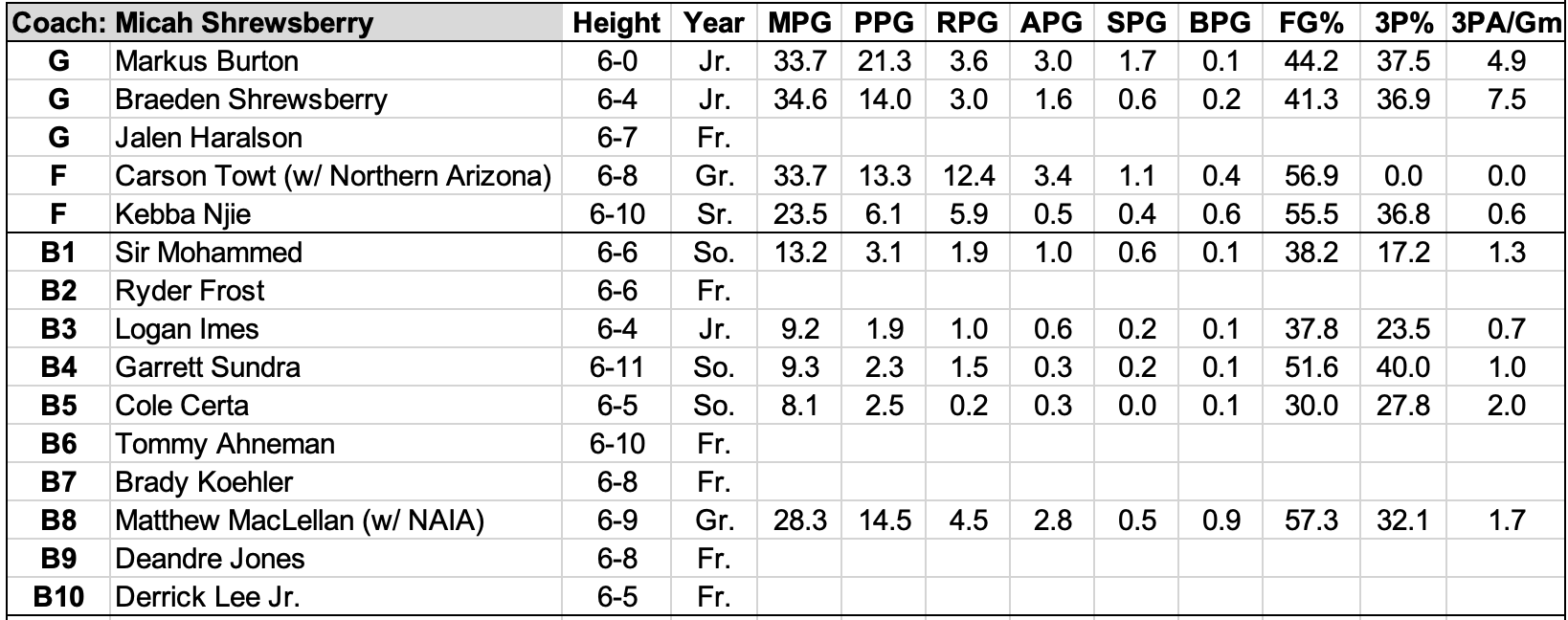
Reasons for Optimism:
Ahhh yes, the continuity conundrum…
On the heels of a frustrating season, which failed to meet last season’s lofty expectations, roster adjustments were necessary. Losing a couple productive parts from that team should open up new pathways for growth, especially with the talent percolation in this pipeline.
Not to discount the value in bringing back Markus Burton and Braeden Shrewsberry but the skeleton key to a potential NCAA Tournament at-large bid lies in the others. Burton does deserve credit for elevating his efficiency as a shotmaker. As the CBBAnalytics.com comparable visuals below show, Burton didn’t alter his shot diet much at all last season. He simply started to find the range from distance, as his 3-point percentages shot up substantially over his rookie campaign. His mid range will always be the bread and butter of his scoring bag but he needs to make 3s at a high rate to balance out the analytics.
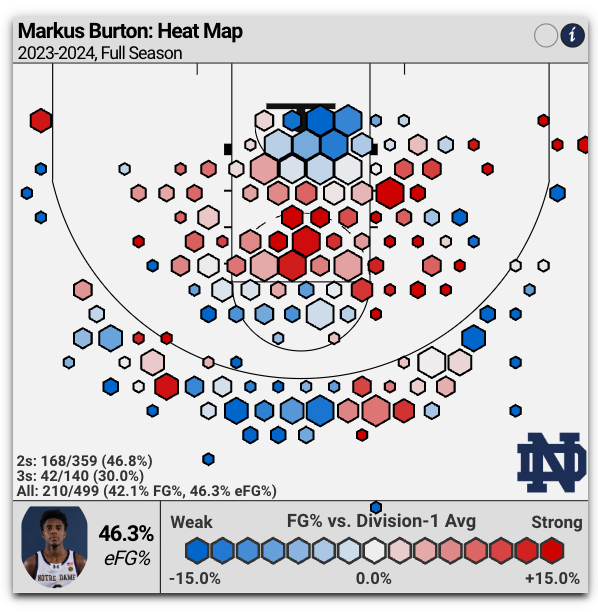
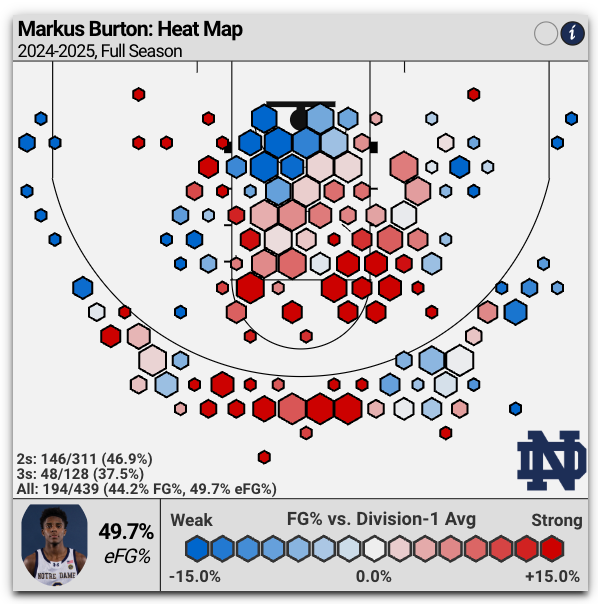
Top-20 prized prospect Jalen Haralson might be the Messiah the Irish need to reach new levels. Or, could that chosen one be last year’s prodigal son, Sir Mohammed, who now feels like the sexy ‘post hype’ breakout candidate after a disappointing rookie campaign?
Haralson is the latest touted Indiana prospect from the La Lumiere talent factory. While he wasn’t wildly consistent throughout this prep career, he had major moments on the EYBL circuit against premier players. As an editorial aside, a few sharp ballknowers in our Discord weren't overly impressed with Haralson when watching on a few different occasions - thus, I’m choosing to curb my enthusiasm for Haralson's ‘takeover’ impact this year.
Positionally, Haralson is a wiry 6-7 wing. The challenge will be playing Haralson and Mohammed together - maybe the solution is to platoon them and ride the hot hand each night? It’s worth mentioning that Haralson has earned his stripes as a committed defender on the other end, which will put him in on the right side of the ledger with Shrewsbury. If Mohammed can shake the rust from a leg injury that delayed his development last year, the Irish have two top end talents to slot at the 3 next to Burton and Shrewsbury.
The luxury with this year’s roster is the lineup flexibility off the ball. Burton will surely be at the epicenter of the offense but keeping him and baby Shrews fresh may pay dividends in the dog days of conference play. This sneaky sophomore class all clocked 10 minutes a game last season - Logan Imes, Garrett Sundra and Cole Certa - and notched critical big game experience. Freshmen Ryder Frost, Tommy Ahneman and Brady Koehler are the other three fringe top-100 prospects who fit into Shrewsbury's developmental wheelhouse. Of this supporting cast group, I’m most bullish on Frost, a deadeye shooter, and Ahneman, a skilled low post operator with adept footwork and touch.
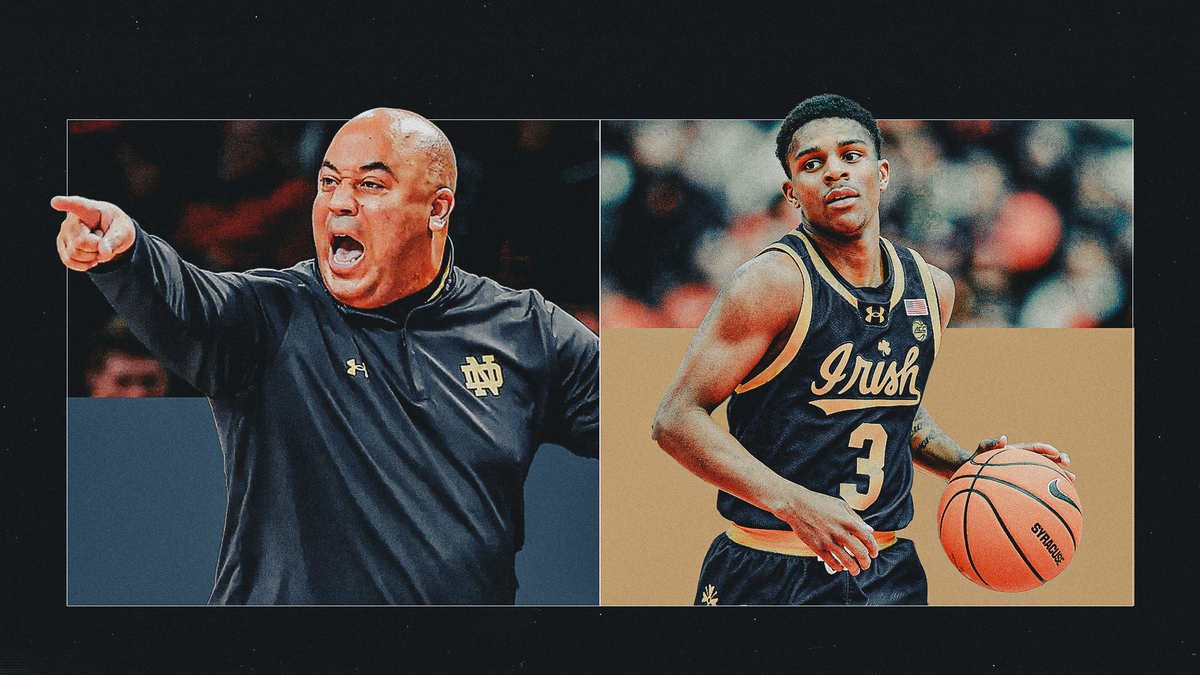
Causes for Concern:
Tae Davis is a big loss, primarily on the offensive end, so Shrews tapped into the portal to find another skilled playmaker 4-spot. In steps Carson Towt, a highly productive offensive engine at NAU and elite rebounder. He’s not as dominant as an interior scorer and finisher as Davis was but he’s quite crafty. Plus, he may be an upgrade from a passing perspective, and thus might be a more effective connecting glue guy on offense.
Defensively, however, last year’s issues may still fester to some degree. Davis was no Rudy Gobert as a shot blocker, but the rim protection responsibilities now fall squarely on Kebba Njie’s shoulders. Njie was a co-anchor of the Irish defense that finished top-50 in KenPom two years back but he had additional support in Carey Booth on a full time basis. The incoming rookies bring additional length but there isn’t a vertical shot blocking stud amongst this group either.
Herein lies the limitations Notre Dame must overcome, which became a glaring issue against stiffer ACC competition last season. The Irish compact defensive structure was able to limit close proximity looks, for the most part. However, when opponents cracked that shell structure, it was game over. Per Haslametrics.com, ND allowed opponents to shoot 63% at the rim last year (bottom 30 nationally overall) and the CBBAnalytics.com shot chart below brings to light this interior blood bath:
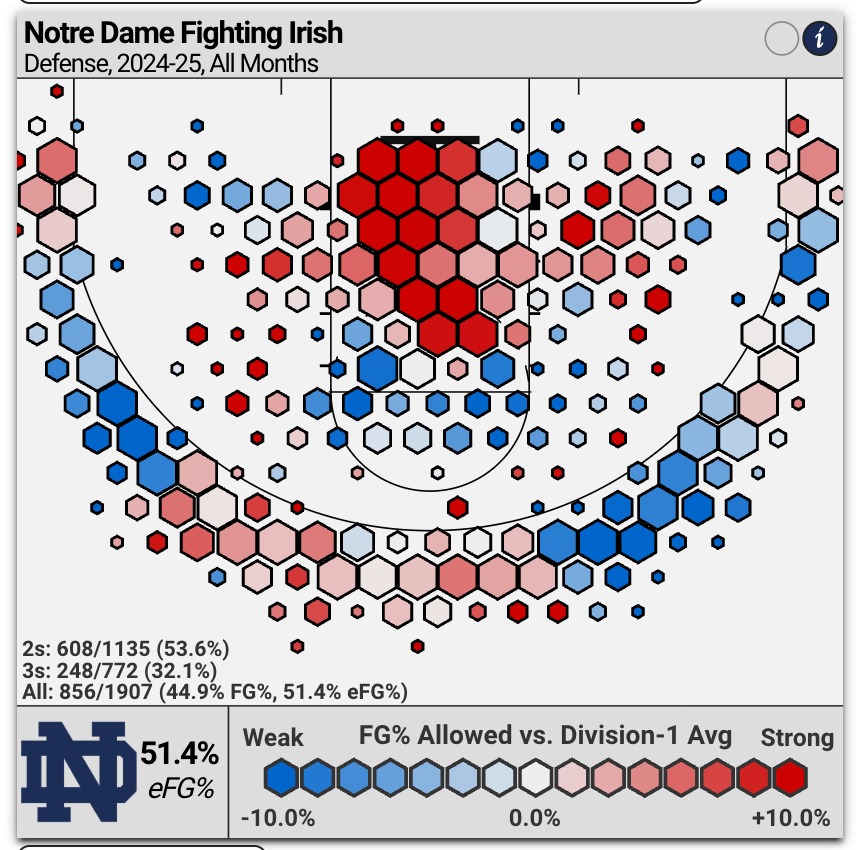
Perhaps the coaching staff was fooled by the first month of the season, when the interior rim protection was ‘passable’.
Now, look at the stark difference in the Irish’s defensive shot chart for the month of November (not that bad) compared to the month of February (very bad):
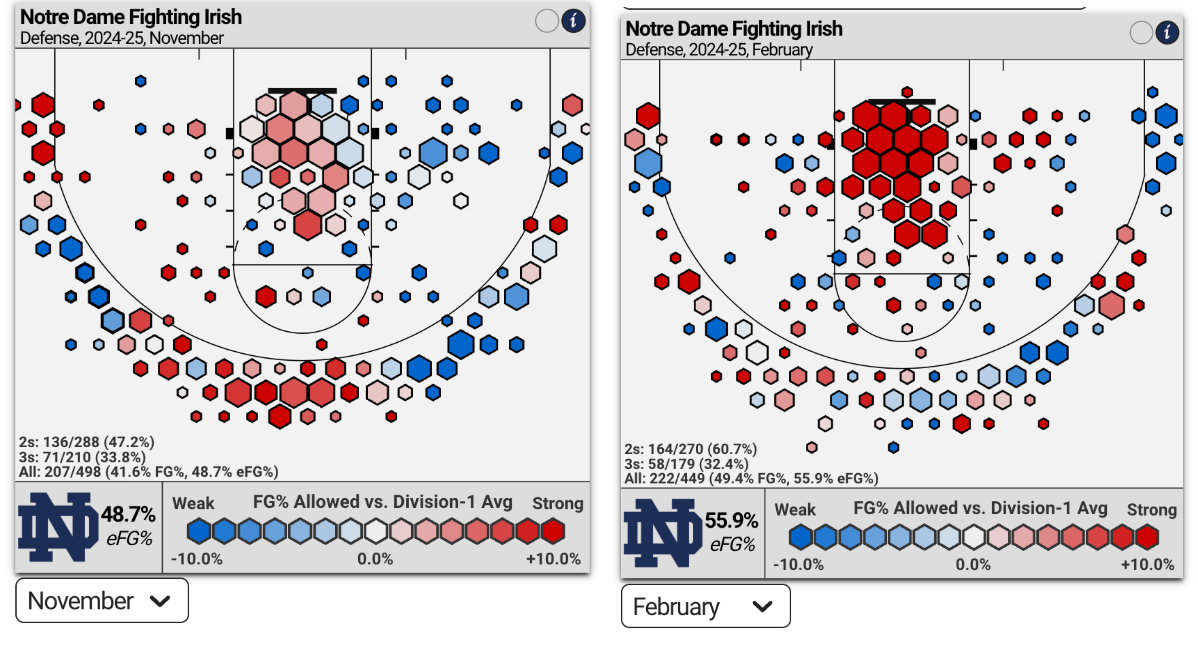
The Irish’s non-conference performance may come down to matchups. And by the time ACC play comes around in January, Shrewsbury will need to identify a stopgap solution to prevent a repeat of last year’s failures.
Bottom Line:
For the Irish to forge higher in the ACC standings, and get out of the middling mush, it needs a ceiling lifter. From an offensive lens, the talent level is on the rise thanks to another strong recruiting class.
However, the defensive question marks still make me queasy. Shrewsbury is convinced a reinvigorated mentality will help course correct this problem but its hard to deny the personnel limitations, specifically at the 5 position, unless an unsung hero emerges next to Njie.
10) Clemson
Key Returners:
Dillon Hunter
Key Losses:
Ian Schieffelin, Chase Hunter, Viktor Lakhin, Jaeden Zackery, Chauncey Wiggins
Key Newcomers:
Jestin Porter, Butta Johnson, Nick Davidson, Carter Welling, RJ Godfrey, Jake Wahlin, Zac Foster
Roster:
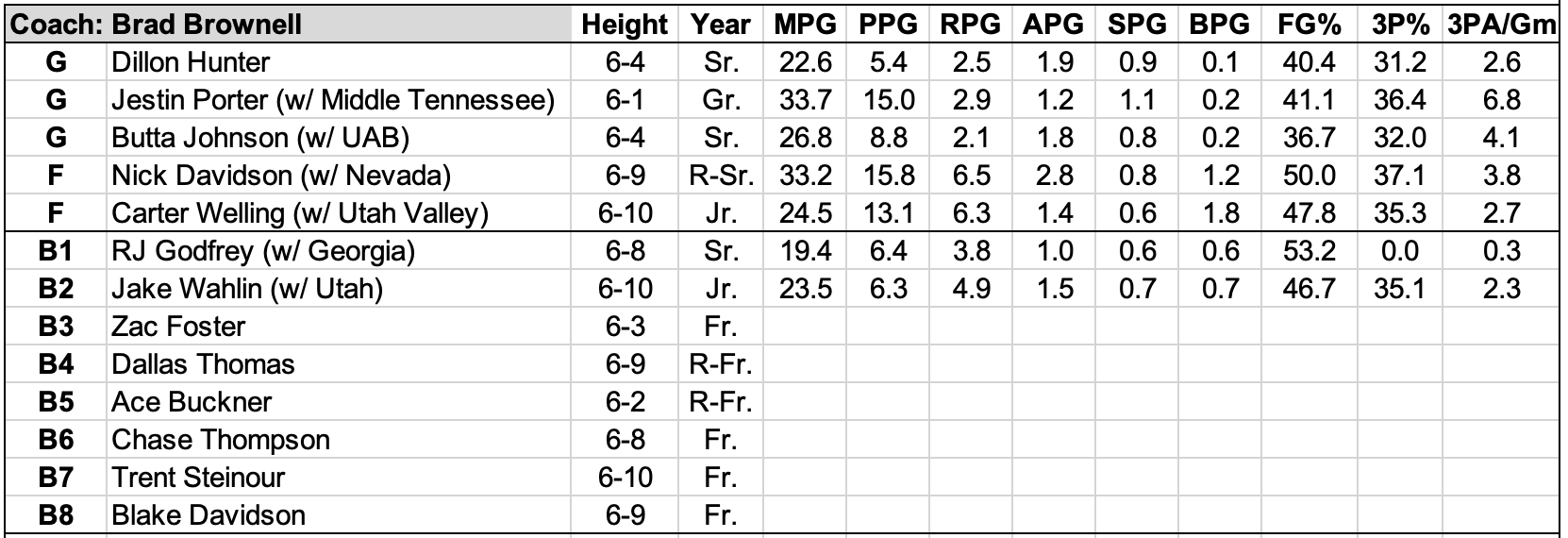
Reasons for Optimism:
It’s a full housecleaning for Brad Brownell, the ACC’s coach cockroach that is impossible to squash. Well, unless facing a tricky Will Wade matchup zone in the NCAA Tournament.
The margin for error is always thin with Brownell’s rosters but the portal haul properly replenished the frontline to Brownell’s liking. It starts with Nick Davidson, a highly skilled and crafty forward from Nevada. I’ll refrain from overindexing on convenient PJ Hall comparisons but Davidson is qualified to serve as a similar inside-out fluid forward triggerman that Hall was.
Davidson can operate in traditional back to basket post ups but he’s most effective around the mid post area, where he can face up and attack off the dribble. In fact, Davidson’s Synergy post up possession splits, per Synergy, weren’t great. This was partly due to Nevada’s shaky shooting, artificially harming his ‘post up + passes’ Synergy marks, but even Davidson himself only converted 44% of his shots generated out of post touches last year.
Still, Brownell’s smart enough to unlock his talents in effective ways. who’s explicitly proud of how he adjusts his schematics to his personnel, to deploy Davidson in unique ways to generate offense.
Positionally, Davidson makes sense at the 4, assuming Carter Welling stays healthy and cements himself as a feared rim presence defensively. Frankly, the former Utah Valley product drove me nuts watching him try to finish (and fail) around the rim last year but he’s not a raw offensive project by any stretch - he simply needs more refinement. Brownell may incite additional confidence in his developing shooting stroke, which could enable efficient offensive sets with Welling as a pick-n-pop dance partner.
On defense, Welling’s length and verticality was an impenetrable wall around the restricted area for Utah Valley last season. It's a bummer he’ll miss the summer with a foot injury but it sounds like he’ll be back for the start of the season.
Brownell also wanted to infuse a current of athleticism back into this roster this year. Boomerang transfer RJ Godfrey returns to the ring. It’d be great if Godfrey would develop any semblance of a shooting touch but he’s a dependable, know-your-role garbage guy blessed with an action figure frame.
Along with 6-10 import Jake Wahlin, Brownell will face a similar lineup conundrum as last season with Chauncey Wiggins. On the surface, Wiggins was a unicorn prototype as a 6-10 ‘3-and-D’ wing. However, the fit simply didn’t work as a unit.
Per the CBBAnalyics.com chart below, of Clemson’s eight most frequently used lineups last season, Wiggins was on the bench for Clemson’s four best groupings (top four rows). It’s not that the Tigers were 'bad' with Wiggins on the floor but, statistically, they were better served playing either Heidbreder or one of the Hunters on the wing instead:
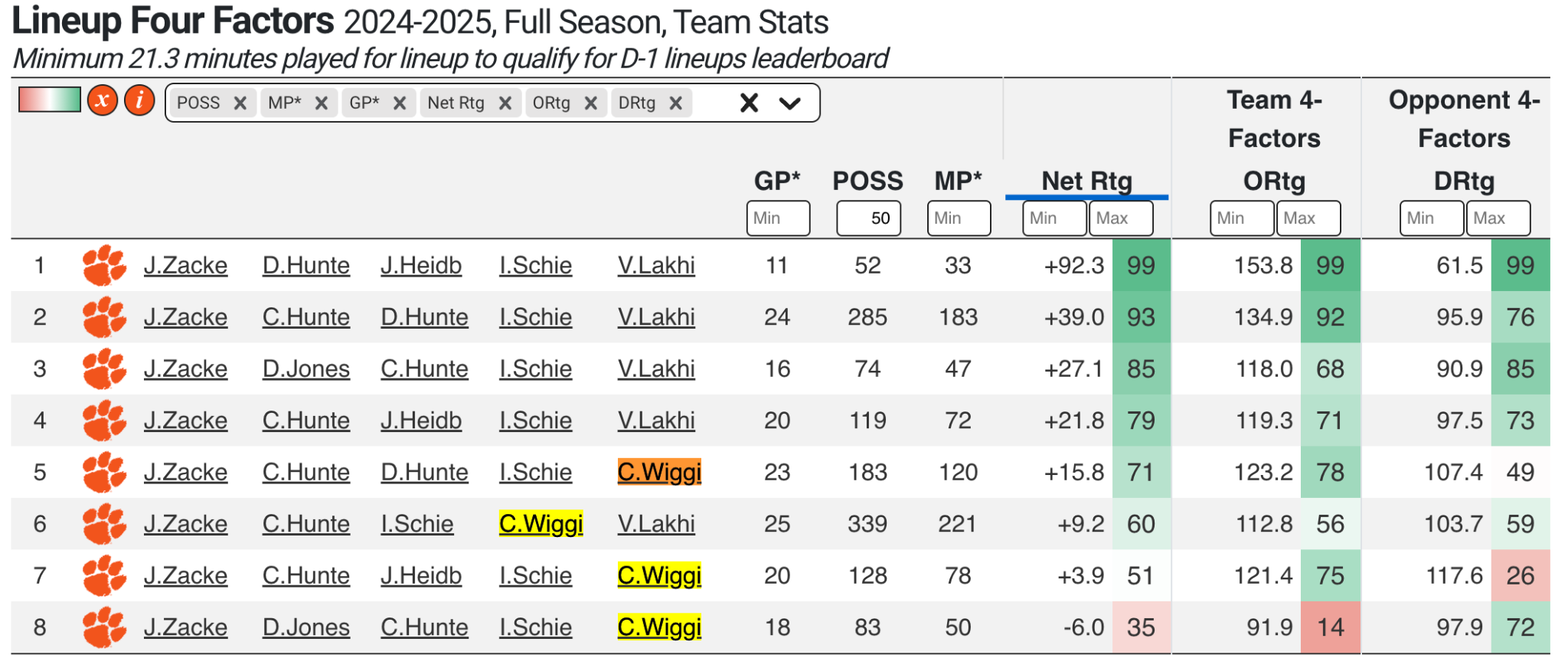
Brownell should tread lightly with playing Wahlin at the 3 but he might also be a better fit to backfill Wiggins’ shoes, if Brownell wants that same length defensively (Wahlin moves and plays like a perimeter player).
More broadly, it’s easy to buy stock in a group of grizzled vets who have been around the block. Last year’s overachieving success, save the early NCAA Tournament exit, was in large part due to the collective wisdom of ‘Chef’, Hunter and Zackery, among other older hats. This year, Brownell rounded up another ‘been around the block’ bunch, with grad transfer Jestin Porter and senior Butta Johnson expected to slot right into the starting presumably next to Dillon Hunter, the lone holdover from last year’s nucleus.
Porter and Butta’s shotmaking will be the key domino(es) to track this year. Hunter, despite being a quintessential winning intangible asset, isn't a great floor spacer, or scorer, which is where Porter and Butta need to deliver. They’ll be beneficiaries of inside out kick outs from Davidson Porter also needs to create additional looks on his own from the perimeter.
Causes for Concern:
Backfilling the point guard position will be a challenge but Brownell might double down on initiating the offense from the post, thus, reducing the need for a gamebreaking lead guard. The target should be to identify shooting first and patch the playmaking pieces around that. Clemson’s shooting suffered down the stretch, culminating in a disaster shooting performance against McNeese.
The bigger problem might be developing depth, which Brownell admitted on the Clemson dubcast this summer. This took a toll on his flatlining team down the stretch last year.
“As good as our team was last year, our bench was not as good as I maybe hoped or thought they would be all the time. We played our starters a lot, and some of that was... I could look back and say I should have rested guys a little more, maybe. I've certainly looked at all that, thought about all that. It was hard. Sometimes we needed guys to make shots, and they couldn't. We just didn't make them. In that McNeese game, we were 0 for 9, 1 for like 13 from three. You go back and look at them, and I mean, 10 of them are... nine or 10 of them out of 13 are pretty open.”
The young guns are going to have to contribute right away, at least in part, to avoid major mileage piling up on the legs of the upperclassmen. You can essentially draw a line to divide this roster into two chunks: 1) the seasoned veterans and 2) the green freshmen - though, two of these freshmen are returning from redshirt seasons.
Perhaps Dallas Thomas and Ace Buckner, two fringe 4-star prospects who sat out idle last year, can make a splash early on. Thomas is the bouncy upside bet but he still feels immature in as far as skill refinement and broader basketball IQ. Bucknell will be asked to aid in the ball handling department but, like Thomas, he still doesn’t have many reps yet at this level.
Zac Foster and Chase Thompson are the most lauded of the true rookies. Foster looks thin but he glides with easy athleticism, often catching defenders off guard by how much ground he covers with each stride. In time, Foster could be a lethal playmaker. Thompson, on the other hand, has a tougher path to major minutes this season but his athleticism could be a refreshing boost to the frontcourt.
Bottom Line:
Clemson’s portal class isn’t dripping with jaw-dropping talent but when is Clemson ever the most talented team in the room? The search for shooting and perimeter playmaking will lead Brownell to finding an equilibrium of inside out balance and reduce the burden on Davidson’s shoulders offensively. If the defensive backbone remains intact, the Tigers could easily climb closer to the top-5 of the standings but it may be a bubblicious March for Brownell and company come March.
11) Wake Forest
Key Returners:
Juke Harris, Tre'Von Spillers, Omaha Biliew
Key Losses:
Efton Reid, Hunter Sallis, Cameron Hildreth
Key Newcomers:
Nate Calmese, Myles Colvin, Cooper Schwieger, Mekhi Mason, Sebastian Akins
Roster:
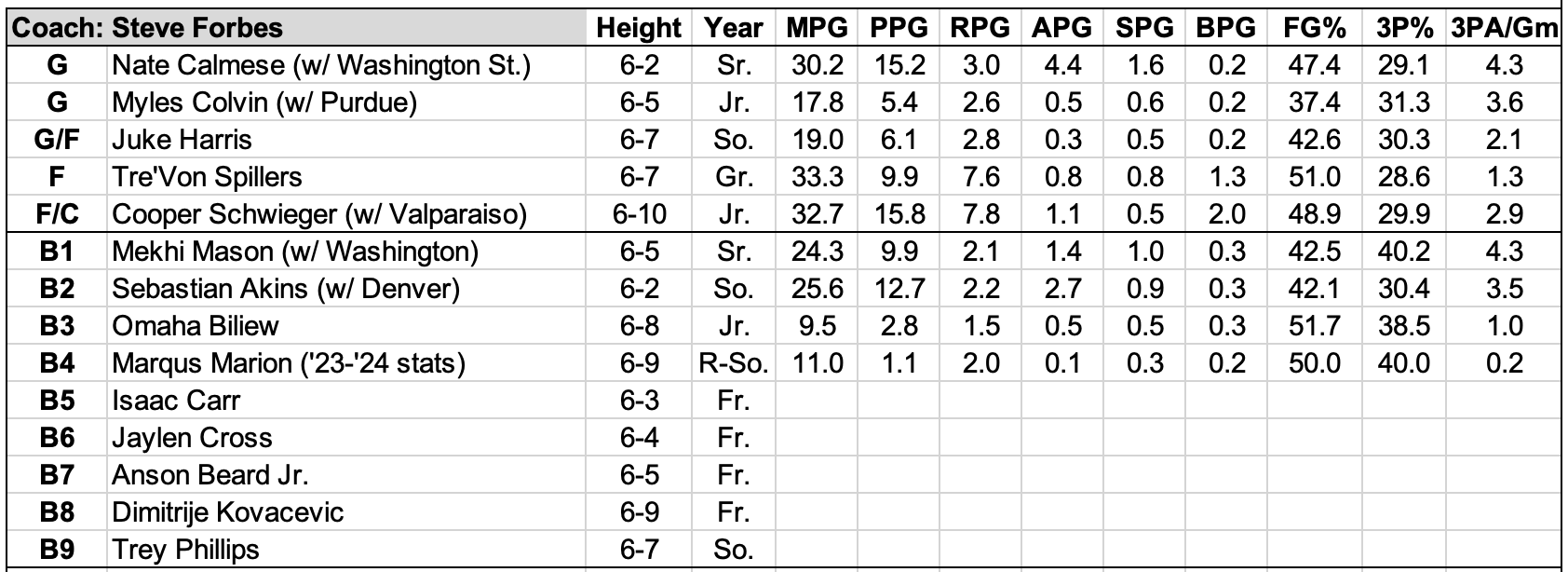
Reasons for Optimism:
*Be sure to check out Brian Geisinger’s detailed breakdown on Nate Calmese*
Hunter Sallis and Efton Reid’s don’t grow on trees. But, in the ‘Wake’ of another close-but-no-cigar season, a roster reset this offseason feels proper. Psychologically, it should be a refreshing sense of relief to put to bed the volatile in-season fluctuations this nucleus endured the last two years. Now, with less of a target on their back, is this the year Forbes reminds us of his once unflappable coaching reputation earned from his terrific tenure at East Tennessee State?
To shake things up offensively, Forbes is bringing in an NBA perspective in assistant Nick Friedman. Last year’s offense was such an eyesore, devoid of both spacing and ball movement. Half court action became overly reliant on Efton Reid post ups, Hunter Sallis pull ups or others burrowing their way to the rim. Despite doubts about the engines of this year’s backcourt, a fresh approach with more spacing and ball movement should steer this offense back on course.
“I think Nick [Friedman] brings a fresh approach to it,” said Forbes in his offseason media check in. “There's no blame here. I want to make it very clear—those guys that were coaching offense last year—they don't shoot the shots. We have been, up until last year, one of the best offensive teams in the league and in the country. We didn't forget how to do that. It's not that; it's just changing the way we approach a little bit and how we look at offense maybe.”
The returning frontline corps, Juke Harris, Tre’Von Spillers and Omaha Biliew, presents a myriad of enticing offensive possibilities.
- Harris was an overhyped rookie last summer but never felt comfortable in this rigid offense. He’s a nifty slasher and scorer but needs more real estate on the floor to be effective
- Biliew could still bloom into the two-way destroyer touted as a McDonald’s All-American coming out of high school (please, just stay healthy).
- Spillers is good to go, an established rock in the middle with a revved up motor and relentless pursuit of the rim. Despite being undersized, he’s a powerful low center of gravity post attacker and crafty left-handed finisher.
On the other end, Spillers’ rebounding and defense underpinned the identity of last year’s team, which had to rely on stops to stay in games during extended scoring droughts. Forbes’ defensive adaptability should be commended last year. He tinkered with multiple defensive fronts, including a strategically timed zone to help keep Wake in games during foul trouble. The depth may look a little dicey this year, but I expect Forbes to be on his toes again, ready to throw a defensive curve ball or two as needed - at his core, Forbes is still a devout man-to-man disciple.
Rebounding was a problem at times last year, even with Reid roaming the middle, but Cooper Schwieger could be a remedy in that department. In a stout Missouri Valley Conference arena, Schwieger emerged as a defensive presence up front defensively, to go along with his rebounding production. On the other end, don’t be surprised to see this system unlock his passing ability, if Forbes deploys him as an internal hub on offense. In spite of his low ish assist rate last year at Valpo, he set up a ton of open shots with the defensive attention he drew.
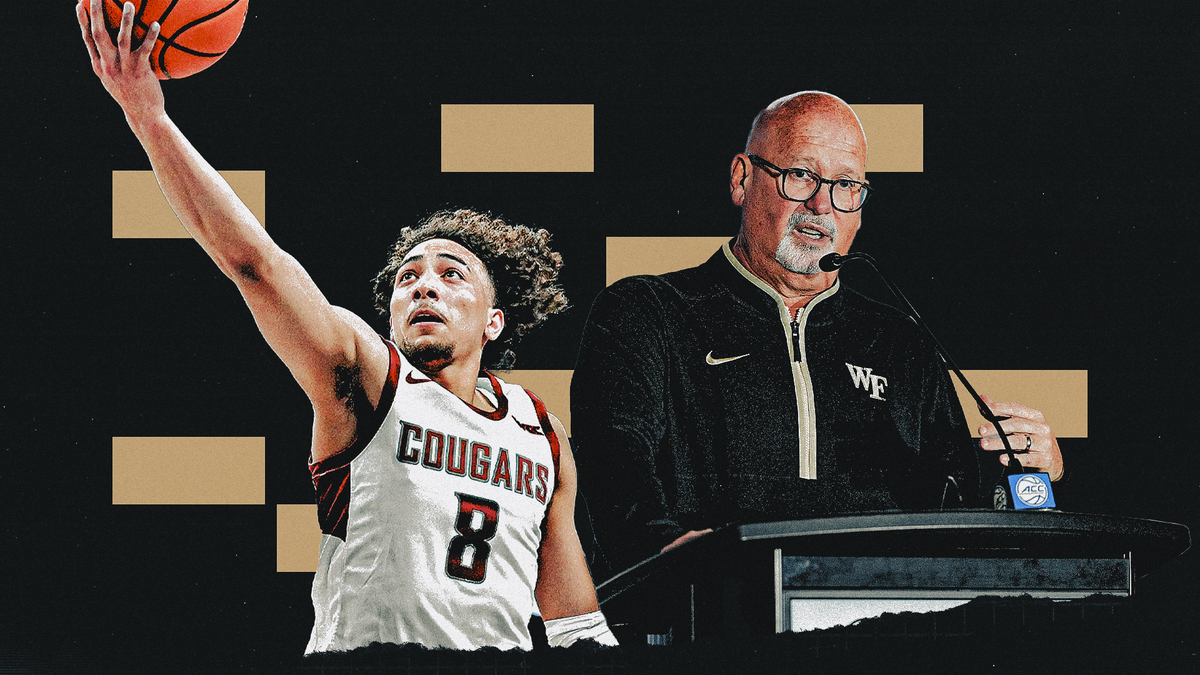
Causes for Concern:
Forbes’ intent to push a few different buttons and pull a few different levers is admirable. However, it does illuminate an identity crisis he finds himself in as a coach, amplified by this new era of player movement where continuity is impossible to find.
There may not be another player in the ACC who qualifies as a bigger X-Factor than Nate Calmese. In hindsight, my offseason portal analysis of Nate Calmese feels a tad bearish upon further review…
- Calmese’s breakout campaign last year caught me by surprise but it was clear he found an oasis playing in David Riley’s system. Of all the Washington State defectors, Calmese is the one I remain slightly skeptical of. For one, he has a long way to go to prove he’s a consistent long range shooter (and Wake fans learned the perils of relying on a non-shooting point guard last year). He’s a much better shot maker than Johnson, so that’s probably an unfair comparison. Still, the fit at Washington State was tailor made for his skill set. He’s super crafty operating in ball screens but he’s not crazy explosive, which is worrisome if defenders don’t respect him as a shooter in the ACC. If he has to carry a heavy shot creation burden in Winston Salem, I fear his efficiency takes a nosedive
In Calmese’s defense, he shot much better in a less ball dominant role at Lamar. Last season, he was asked to carry a heavy load at Washington State - this was unexpected pivot due to a litany of injuries that reshuffled Wazzu’s roles midseason.
If Calmese can solidify the point guard position, the burgeoning Myles Colvin or the sharpshooting Mekhi Mason are both set up to flourish as off ball play finishers. Colvin is more talented but less proven than Mason, who buried threes at a robotic clip at Washington last season (when healthy).
The wildcard of this backcourt bunch might be Sebastian Akins. This summer Akins teased Vandy fans with a last second detour to Wake, a move closer to home. Sure, he picked on Summit League defenses last year but he might be poised for a big jump in year two. The question mark is shooting, which makes him an easy target to sag or help off until proven otherwise. He’s also right hand dominant, which is exemplified in the crazy big divide in his shot chart heat map, courtesy of CBBAnalytics.com - force him left and he becomes far less efficient working to his weak hand.
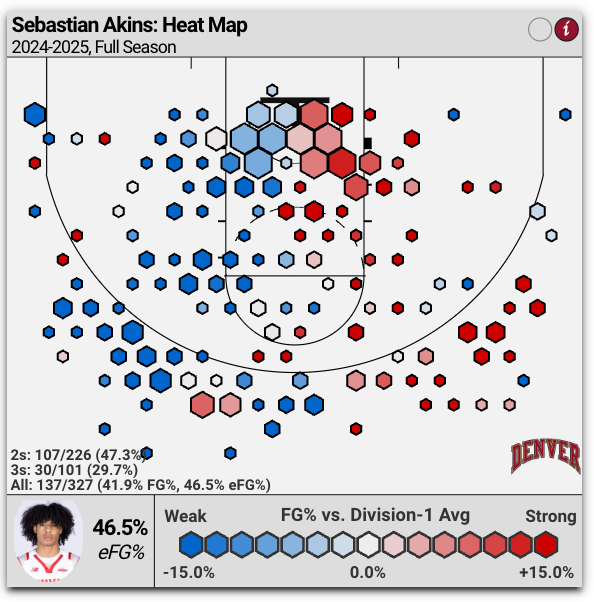
Bottom Line:
It’s been a frustrating ‘tease’ of a tenure for Steve Forbes since arriving in Winston Salem. I’m still a proud shareholder, so perhaps this is the season he pays it off with a trip back to the dance. It all starts with Calmese, and to a lesser extent Akins. The wing and frontline assets will not function properly without a steady floor general, as Forbes learned the hard way last year with the Ty-Laur Johnson experiment.
12) Syracuse
Key Returners:
JJ Starling, Donnie Freeman
Key Losses:
Eddie Lampkin Jr., Chris Bell, Jaquan Carlos, Jyare Davis
Key Newcomers:
Naithan George, Nate Kingz, William Kyle III, Tyler Betsey, Sadiq White Jr., Kiyan Anthony
Roster:
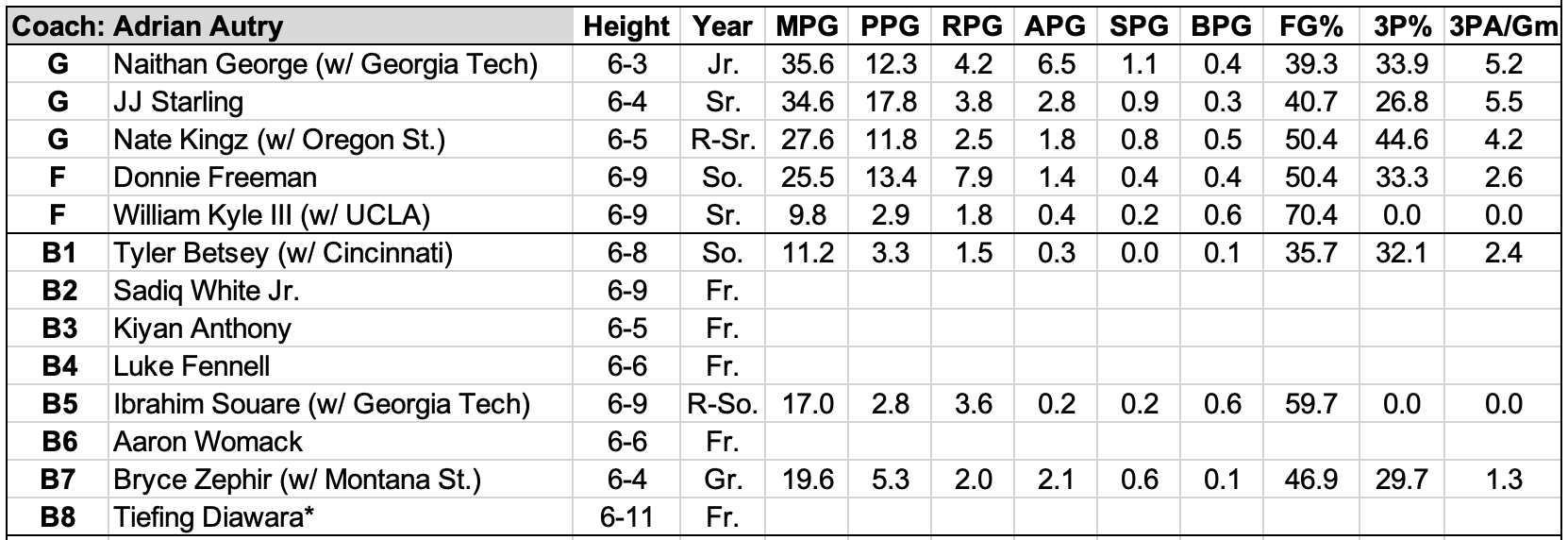
Reasons for Optimism:
“Remember, Red, hope is a good thing, maybe the best of things, and no good thing ever dies.”
Should Syracuse fans follow Andy DuFresne’s advice, and hold out hope for their guy Red? There’s a compelling case on paper, but such was the case the last two seasons with a strong incoming class of talent.
The difference this year is the idea of “fit” was at least considered when assembling the new pieces.
At this point, the Orange finally have a proven high major floor general in Nate George, who is capable of steering the offense with a smarter sense of direction.
Up front, Autry redefined the 5 position, from space-eating roundhouse (Eddie Lampkin) to modern rim protection verticality (William Kyle). Lampkin was a critical portal mistake made by Autry and staff last year. He’s a fun dude to watch get bully buckets inside but his perimeter defensive limitations were preyed upon.
Autry admitted this epiphany over the summer in a brief interview with Cuse Sports Talk:
“I think this game has changed. You need to be mobile, you need to be athletic, and I think we've addressed those needs at that position. William Kyle is an NBA athlete. When you talk about comparisons, you can look at guys like Mitchell Robinson or Robert Williams in the NBA. Those guys' athleticism jumps off the page right away. We're talking about a guy who's 6'9", has a 44-inch vertical, and a 7'3" wingspan. His shot-blocking ability and the way he can move and get up the court—he's faster than some guards. He can guard on the perimeter if we have to switch. His athleticism jumps off the charts right away, and the shot-blocking is something that's appealing.”
Between the point and the paint, the 2, 3 and 4 positions are loaded with depth, talent and versatility. JJ Starling and Donnie Freeman are the polarizing headliners: talented, productive but inconsistent for various reasons.
Starling’s shooting woes have hindered his ability to impact winning, but he’s been bothered by injuries the last couple of seasons. A hand injury slowed his development last year, and his percentages sunk as a result. I’m willing to give him one more mulligan, given he’s able to put the hand pain behind him.
Freeman is looking to bounce back after a foot injury ended his 2024-25 campaign prematurely. His talents are undeniable but he needs to commit to playing both sides of the ball to impact the bottom line.
Both Starling and Freeman will be able to stay fresh this season with the talent waiting in the wings. Nate Kings is a terrific two pronged weapon from Oregon State. His shooting ability might be the eye candy of his profile but his defensive ability is criminally underrated as well. Tyler Betsy is a former top-50 prospect and potential multi-positional plug and play piece at the 3 or 4. He was a first year flop at Cincy but the recruiting pedigree is what Autry is betting on. The crystal ball shows a potential skillful stretch-4 if he can regain his shooting form.
Those proven commodities will be joined by a strong rookie class that carries serious upside. Sadiq White is widely considered one of the most underrated freshmen in this cycle. A late blooming Air Jordan esque athlete, White could be a terror in transition and as a defender. Kiyan Anthony needs no introduction given his lineage but he could be useful as an immediate super sub spark off the bench.
Australian product Luke Fennell turned heads all over the globe this offseason with his dominance at the U19 cup. He can shoot the cover off the ball from deep but he can also initiate the offense as a lead handler and pick-n-roll attacker. It will be hard to find major minutes right away but it may be even harder to keep him off the floor, too.
Luke Fennell hits a tough basket right in AJ Dybantsa’s face🍊 pic.twitter.com/Mdx6lOJNRo
— Sam Stavrakos (@SamStavrakos) June 28, 2025
Causes for Concern:
Syracuse was dominated by ACC foes in the turnover department last year, which left the Orange fighting an uphill battle in terms of shot volume. The Cuse coughed it up at the second highest rate in the league, while finishing dead last in turnovers forced on defense. On offense, a lack of a steady lead handler didn’t help, and on defense, an undefined and unclear identity left this unit in no man’s land, stuck between man to man and zone schemes.
For context, Cuse only played zone on 7% of all defensive possessions last year but Red has yet to master the art of man-to-man.
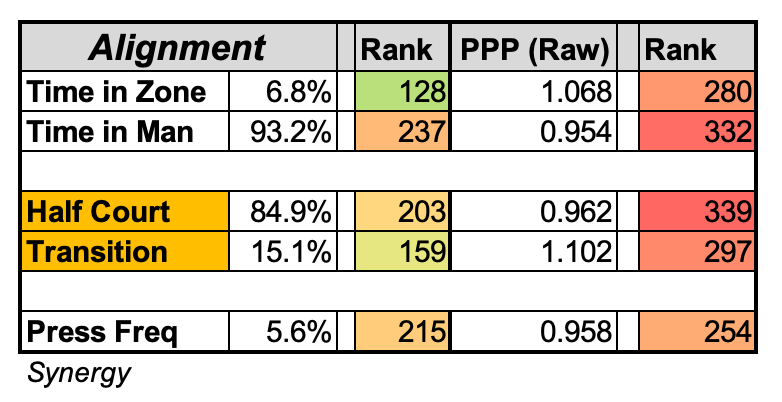
Changing defenses can be an effective strategy but the toggling back and forth can also confound the team playing it, often leading to miscommunication and breakdowns.
The plan this year is to dial up the pressure, though Autry failed to mention any more meaningful details behind the scheme specifics.
“We have to guard the ball better. That's the first and foremost—keeping people in front of us. We have to protect the rim when we do get beat. The one thing we did a good job of last year was rebounding, so we have to continue to do that. We can't get too far away from that, but really guarding the ball better and keeping it in front of us—that's where it starts.”
Two potential defensive specialists could be transfers Idrahim Sourare and Bryce Zephir. They may be relegated to bench mobsters if the rookies take off but also may be key insertions in certain moments throughout the year. Sourare is a liability offensively but he can gobble up some minutes at the 5 to backup Kyle. Zephir is a defensive ballhawk and presumably serves as George’s backup at the point.
Bottom Line:
Alas, another titillating roster for Red Autry, who’s only proven to do less with more. Maybe this is the season he breaks through, and finally lands on a stable schematic identity. In his defense, transitioning away from the Boeheim zone was never an easy one, and the Orange have been out of sorts defensively ever since. If he can fight a blueprint to solve that conundrum on defense - the offseason personnel swaps should help organically - the offensive talent could be sublime as well (especially if Starling can stay healthy).
13) Pittsburgh
Key Returners:
Cameron Corhen, Brandin Cummings
Key Losses:
Jaland Lowe, Ishmael Leggett, Damian Dunn, Zack Austin, Guillermo Diaz Graham
Key Newcomers:
Damarco Minor, Nojus Indrusaitis, Barry Dunning Jr., Dishon Jackson, Roman Siulepa, Omari Witherspoon
Roster:
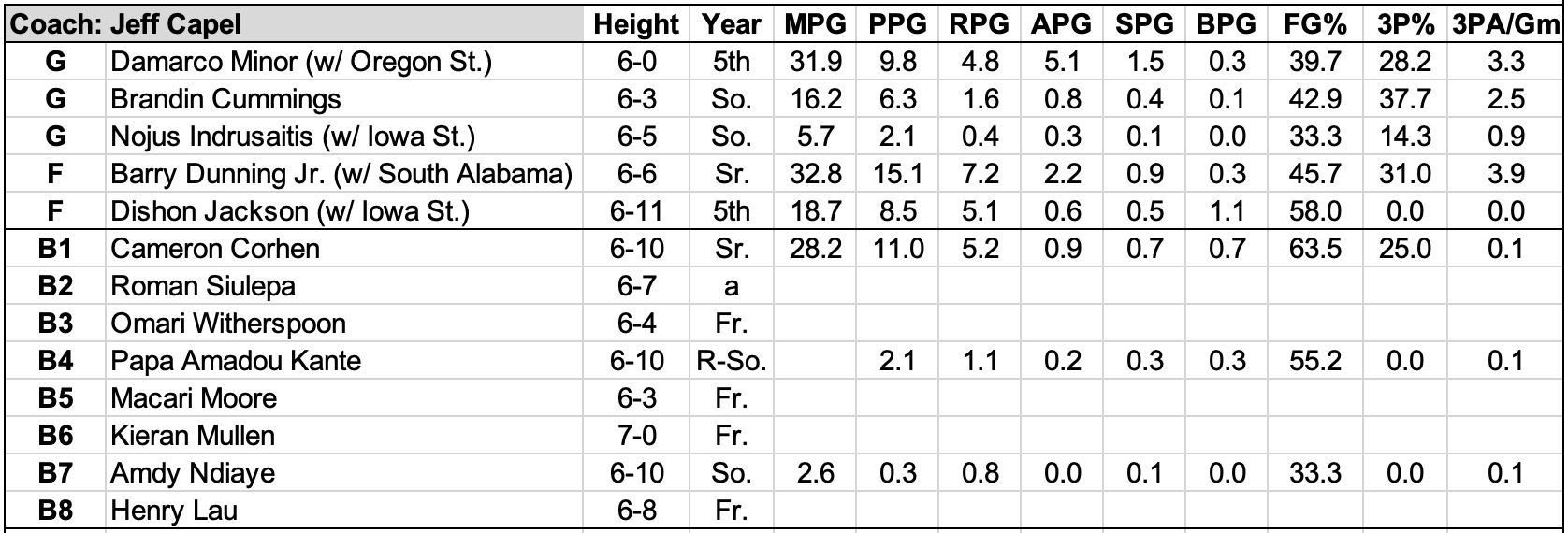
Reasons for Optimism:
The air seems to be seeping out Jeff Capel’s balloon. Last season was the same sad song: a promising start ruined by a sluggish finish. Why did the piping hot Panthers in non conference turn into a pumpkin in ACC play?
One theory is inexperience at the guard position. Capel, purposefully, opted to go in an entirely different direction this summer.
“I didn't think there was the necessary physicality there to be the team that we want to be. I didn't like the way we rebounded. I didn't like the way we defended. I just felt like we needed to become more physical. That was a big thing. I thought we got pushed around a lot. It's weird. Last year was a weird season because we didn't get pushed around in November and December. Whether we ran out of gas or I didn't play enough guys, whatever it is, we have to change.”
Two straight years of young high octane pro prospects, Bub Carrington and Jaland Lowe, now shifts to a gritty old hat at point guard, Damarco Minor. It’s hard not to love Minor, a quintessential hard-nosed floor general with a game straight out of the 1990s. There’s warranted skepticism about Minor being qualified to be a featured initiator on an NCAA Tournament caliber team but he was an indispensable connector on a wildly overachieving Oregon State squad last year, which is exactly the script Minor hopes to write this season.
Minor’s a master of the midrange but his outside range is limited. Smart defenses will dare him to shoot from the outside on ball screens, so Capel will need to be ready for that adjustment but he can live with that limitation. Above all, Minor is one of the best pound for pound rebounders in America at his position.
Capel, along with a flush NIL bag, hauled in fringe top-100 rookie Omari Witherspoon, another burly plus sized guard that leans on physicality. Like Minor, he’s an erratic outside shooter but figures to be in the core rotation early on.
Incumbent sharpshooter and shotmaker Brandin Cummings will help offset Minor and Witherspoon’s shooting shortcomings, and Capel is hoping Barry Dunning can act as a secondary floor spacer, either a small ball 4 or jumbo 3. Dunning resembles the same wing driller prototype as Blake Hinson, a fixture on Capel’s early Pitt teams. Dunning isn’t nearly as proven as a long range sniper, despite his notable 46 point explosion against Texas State last March, but he’s underrated as a finisher and facilitator.
If Dunning’s home stretch performance last year is any indication of his trajectory, he might be an All Conference darkhorse. Per the CBBAnalytics.com chart below, Duning went nuclear over his final 10 games, finishing with a 60% effective field goal percentage by scoring efficiently from all over the floor.
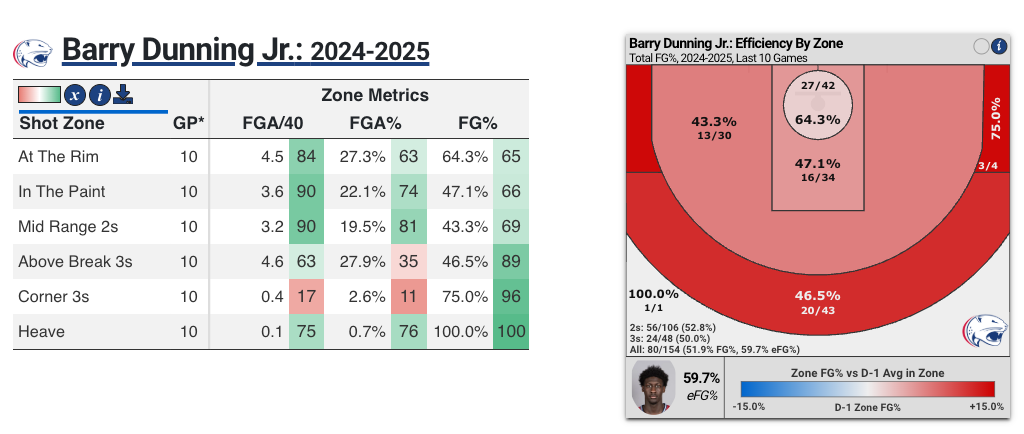
Circling back to the tenant of physicality and toughness, Capel added muscle to the frontline in Dishon Jackson to augment the returners, Cam Corhen and Papa Kante. Beanstalks Keirnan Mullen and Amdy Ndiaye will provide additional depth.
Corhen is what he is at this juncture - a highly effective interior finisher with sound touch around the rim. Last year, he was a major benefactor of an elite pick-n-roll dance partner last season in Land and Leggett, so developing that same rim runner chemistry with Minor will be pivotal.
Capel is hoping Jackson brings a different dimension to this offense. The gigantic post presence with a pretty passing ability is still scratching the surface of his potential. Jackson’s slow burn growth is largely the fault of injuries, but he carved out an effective low minute niche as a reserve at Iowa State. The vision might be a Corhen and Jackson splitting 35-40 minutes a night at the 5 spot.
Speaking of physicality, Aussie native Roman Siulepa is a certified unit. Capel thinks he can set the tone for this frontline.
“We know there's a physicality that's there. We know there's a guy that plays really hard, has upside and versatility. We think that he will help us rebounding and just give us a different type of guy, whether it's on the wing or inside. He can play inside and out. He's big, strong, and athletic, and he's got a little nastiness to him, which is really good. We're excited about what he can bring.”
Causes for Concern:
The backcourt pieces seem to fall naturally in place but Capel faces a tricky problem in optimizing his horses up front.
The obvious starting point is, how much will Capel deploy Jackson and Corhen together, if at all? If Capel learned anything from last season’s lineup juggling act, he may opt to avoid the twin tower approach, which was far less effective.
Using CBBAnalytics.com to isolate the lineup pairings last year, we see the difference between the 4-out, 1-in lineup compared to the 2-big jumbo lineup. Whether it was Corhen or Graham at the 5, Pitt was way better off with only one of the true bigs out there at time, not both. The Panthers were outscored by 73 points with Corhen and Graham on the floor together, as shown in the bottom row below:

What’s particularly alarming is Capel failed to identify this limitation. This lineup clocked the highest minute count (304 minutes) of the three options shown above. Furthermore, the additional size actually produced the worst defensive outcomes, surrendering a porous 116.3 points per 100 possessions on those trips.
That said, the 4 around 1 lineup only works with proven perimeter firepower. Capel will need a big splash from another Iowa State transfer, Nojus Indrusaitis. Indrusaitis’ heralded shooting ability was never on display last year in Ames but he could be a legit catch-and-shoot asset in this rotation.
Finally, big things are expected of Bradin ‘Beebah’ Cummings in year two. He’s already well advanced in his development arc, and seems to be flying under the radar as a potential All Conference breakout bet. Cummings went ballistic a few times last season, proving he can be a legitimate starting combo guard in the ACC capable of catching fire.
Bottom Line:
The Panthers are forging a new identity this season, grittier and older, but still with a splash of youth upside and long range shooting. The addition of Minor at point and Jackson up front are clear indicators of the toughness Capel so badly desires. The ceiling may not be as high as prior years but this rendition might surprise people as the hunter rather than the hunted.
14) Florida State
Key Returners:
None
Key Losses:
Jamir Watkins, Malique Ewin
Key Newcomers:
Robert McCray V, Kobe MaGee, Lajae Jones, Chauncey Wiggins, Alex Steen, Martin Somerville
Roster:

Reasons for Optimism:
Luke Loucks is young, sharp and innovative. Despite the resource limitations facing his first roster rebuild, he cobbled together an intriguing starting five, along with a few flier upside bets off the bench. Depth is certainly not a strength but such is an unavoidable tradeoff operating under FSU’s hoop budget constraints.
For a deeper schematic analysis of Loucks’ blueprint, be sure to read Jordan Majewski’s breakdown in “New Coaches, New Schemes”, where he highlights the similarities between Loucks and BYU’s Kevin Young.
Loucks clearly had a type in attacking the portal: proven production at strong mid-major programs. Robert McCray and Martin Somerville have bigger hurdles to clear coming from the ASUN and AEast, respectively, but neither should be shellshocked by this transition. McCray started at Wake, and now gets a second bite at the ACC apple after dominating the ASUN for a top-4 team in the league last year. I’m not sold that he can score at the same clip against ACC defenders but he might be willing to evolve into a pass-first playmaker, rather than score-first alpha, as he was at Jacksonville.
Letting McCray loose in transition and hunt shooters on the perimeter might be the best path forward for the ‘Noles offense. Somerville was a certified bucket at UMass Lowell but he has a proven transferable skillset as a spot up catch and shoot threat. Per Synergy, Somerville made 51 of his 110 triples in catch and shoot situations (46.4%), one of the highest clips in the country. The picture below ranks the top catch and shoot scorers in college basketball last year with over 100 attempts. Somerville, along with teammate Kobe Magee, cracked the top-30 nationally.
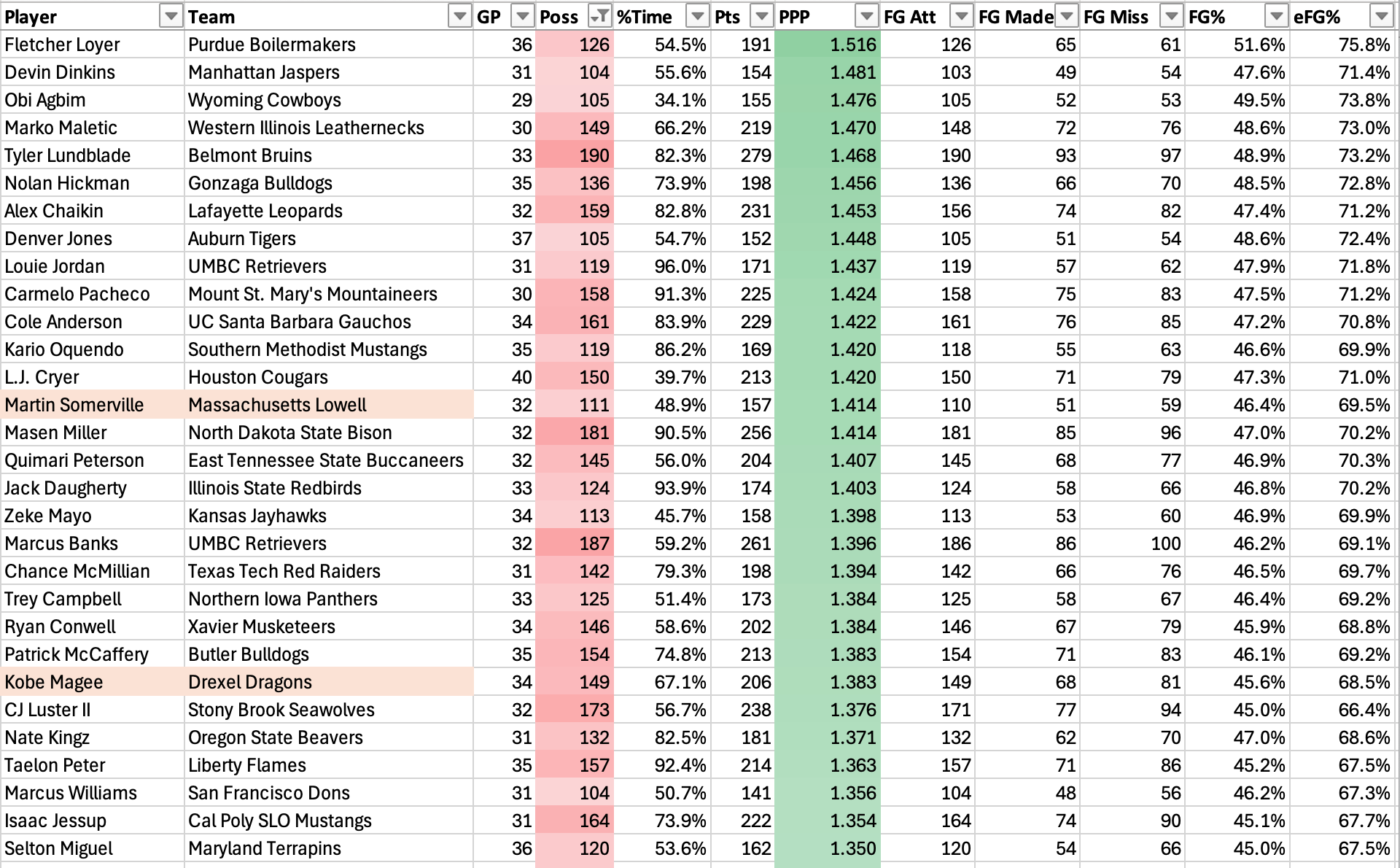
Loucks’ NBA fingerprints are all over this roster with the emphasis on shooting, from Somerville to Magee to St. Bonaventure transfer Lajae Jones. Jones is the pinnacle of a 3-and-D specialist, while Magee projects as a versatile part shooter / part handler on the wing. Even jumbo wing Chauncey Wiggins, who made 39% from long range in ACC play at Clemson last season, can stretch the defense from the 3 or 4 spot.
The surplus of shooting surrounding lauded D-II transfer Alex Steen in the middle is an enticing mix. He feels undersized for a high major post player but his skill and fluidity might create mismatch problems for opposing defenses. He may be pushed around by grown men inside but he won back to back Defensive Player of the Year awards in his conference at the D-II ranks, mostly because of his shot blocking.
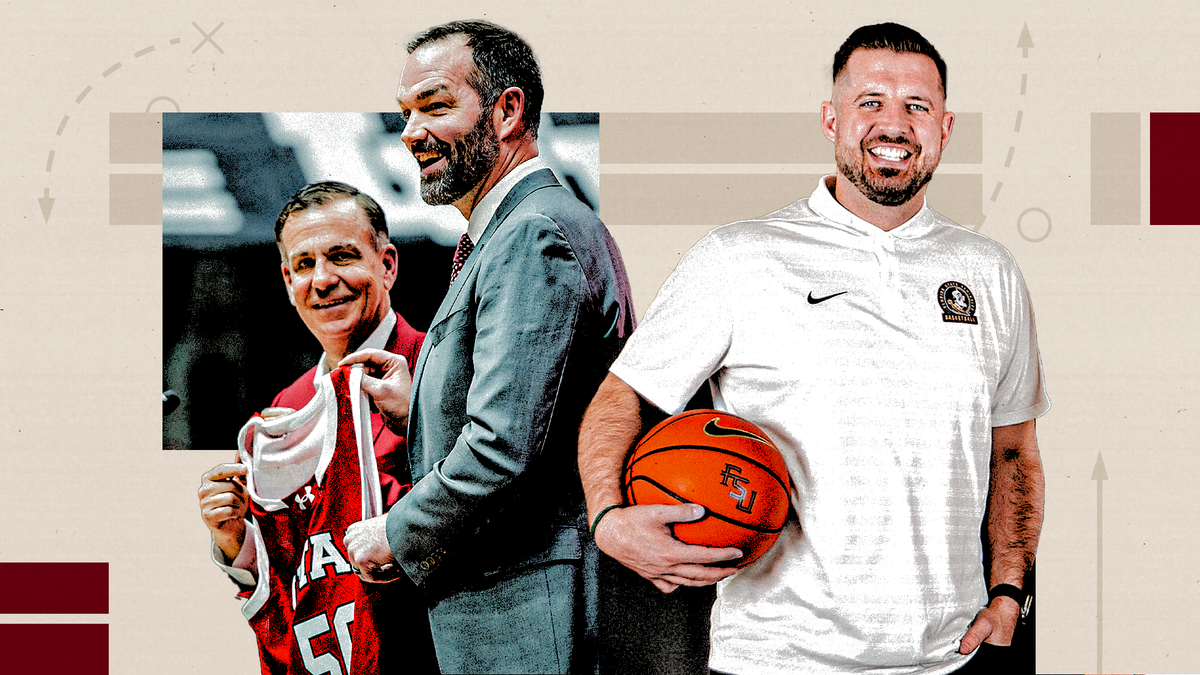
Causes for Concern:
The bench is mighty thin, at least as far as proven commodities go, so Loucks may struggle to dip deep into his rotation against stiff competition.
Thomas Bassong could be the deep sleeper of this unheralded group. Bassong made a few head turning plays in the FIBA U19 tournament this summer. The OTE product has crazy vertical bounce, and could be a force in transition with room to stretch his legs. He should be an asset as a helpside defender and perhaps a secondary slasher in time.
Some nice driving + grab-and-go flashes from FSU commit Thomas Bassong in the France-USA game last week — 7-3 wingspan + power-stride combo to get by Mikel Brown on this possession pic.twitter.com/eSGS8vNz2P
— Brian Geisinger (@bgeis_bird) July 8, 2025
Returners AJ Swinton and Alier Maluk each had brief moments last year in Hamilton’s swan song season. They aren’t chopped liver by any stretch, but I’d expect Loucks to lean on his top dogs for heavy workloads all year.
Loucks was hoping international prospect Egor Ryzhov could add another bullet to the chamber but he did an about-face this summer, and is no longer with the program. Can former Temple commit Cam Miles step in and provide 8-10 minutes a game? Can Shahid Muhammad spell Steen at the 5 in a similar capacity? The deeper you dive on the depth chart, the greater the unknowns…
Bottom Line:
It’s a scary notion going to battle with a thin, inexperienced bench but as long as Loucks can manage the workload of his thoroughbred transfers, FSU may be a tough out on most nights in the ACC. Schematically, Loucks seems to be pressing the right buttons but we’ll see if the inexperience rears its ugly head with a short rotation and virtually zero margin for error - staying healthy might be the most important factor in Loucks’ first season.
15) Boston College
Key Returners:
Fred Payne, Donald Hand Jr., Jayden Hastings
Key Losses:
Chad Venning, Elijah Strong, Dion Brown
Key Newcomers:
Chase Forte, Aidan Shaw, Jason Asemota, Marko Radunovic, Boden Kapke
Roster:
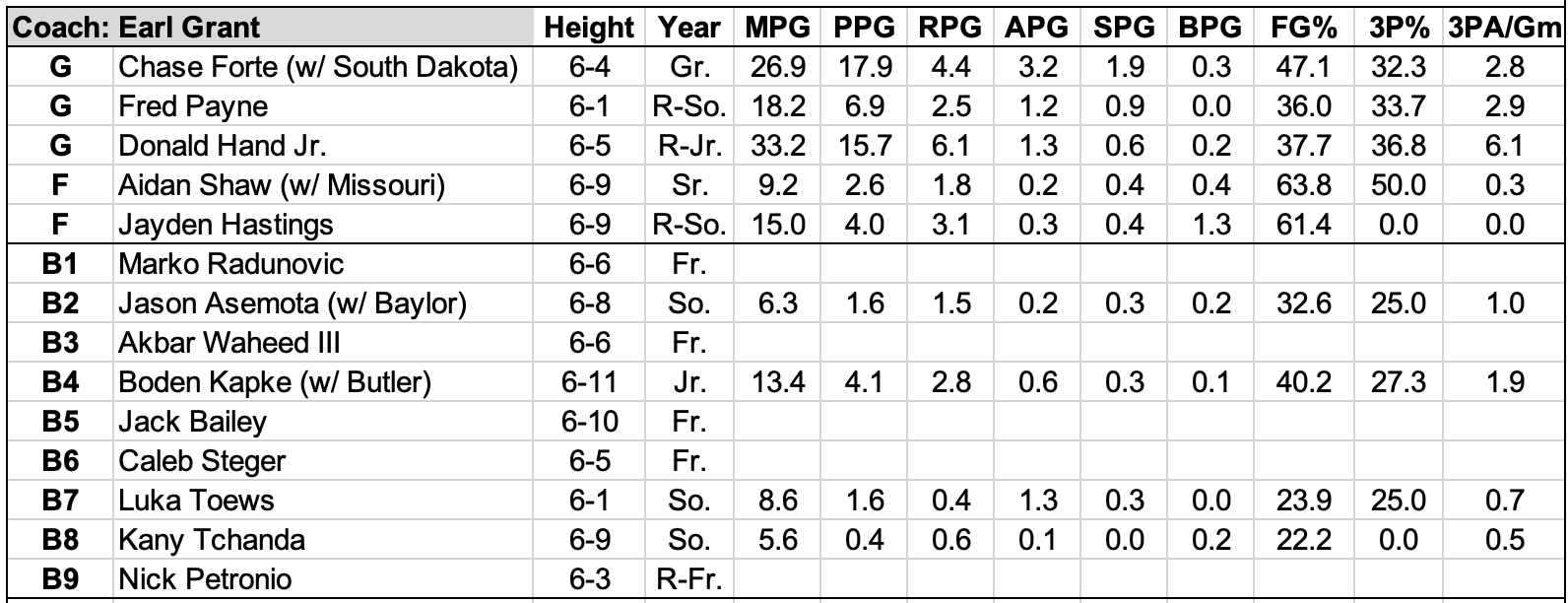
Reasons for Optimism:
It was a talent wasteland last year in Chesnut Hill. No one expects Boston College to lure big fish out of the portal, for numerous reasons, but last season was a stark drop off from the Quinten Post led squad the year prior.
Extrapolating Grant’s strategy this summer from his acquisitions out of the portal, it seems as if he's starting to fish in the power conference ponds for underappreciated assets. Put differently, he’s less interested in trying to put lipstick on a pig with productive transfers from low major programs, a strategy that’s yielded a few duds out of the portal in recent years.
Jason Asemota isn’t getting the same ink as the more proven transfer pick ups but his upside is considerable. The local Lynn, MA native and former 4-star recruit is seeking immediate playing time after being buried at Baylor. Asemota didn’t showcase his shooting ability last year but he was regarded as a dangerous shotmaker all throughout high school - he himself even compared himself to Jayson Tatum and Paul George, just to give a sense for the prototype (no, he’s not as good as those guys).
Mizzou transfer Aidan Shaw is another high major, high octane athlete with pogo stick hops. The ultimate upside play could be putting Shaw in the dunker spot at the 4, Asemota at the 3, and then Jayden Hastings at the 5. While extremely raw on the offensive end, Hastings’ rim protection started to blossom late in the year last season.
The big X-Factor is at point guard, where BC badly needed an upgrade this year. Chase Forte comes from a frenetic system at South Dakota but he’s a proven initiator with power conference speed and strength. Above all, he’s durable and dependable.
Per Synergy, only 25 players in college basketball accounted for 500 or more possessions as the primary pick-n-roll ball handler (including passes) last year. Of this esteemed group of super high usage lead guards, Forte’s efficiency ranked in the lower half but still in the neighborhood of some marquee names.
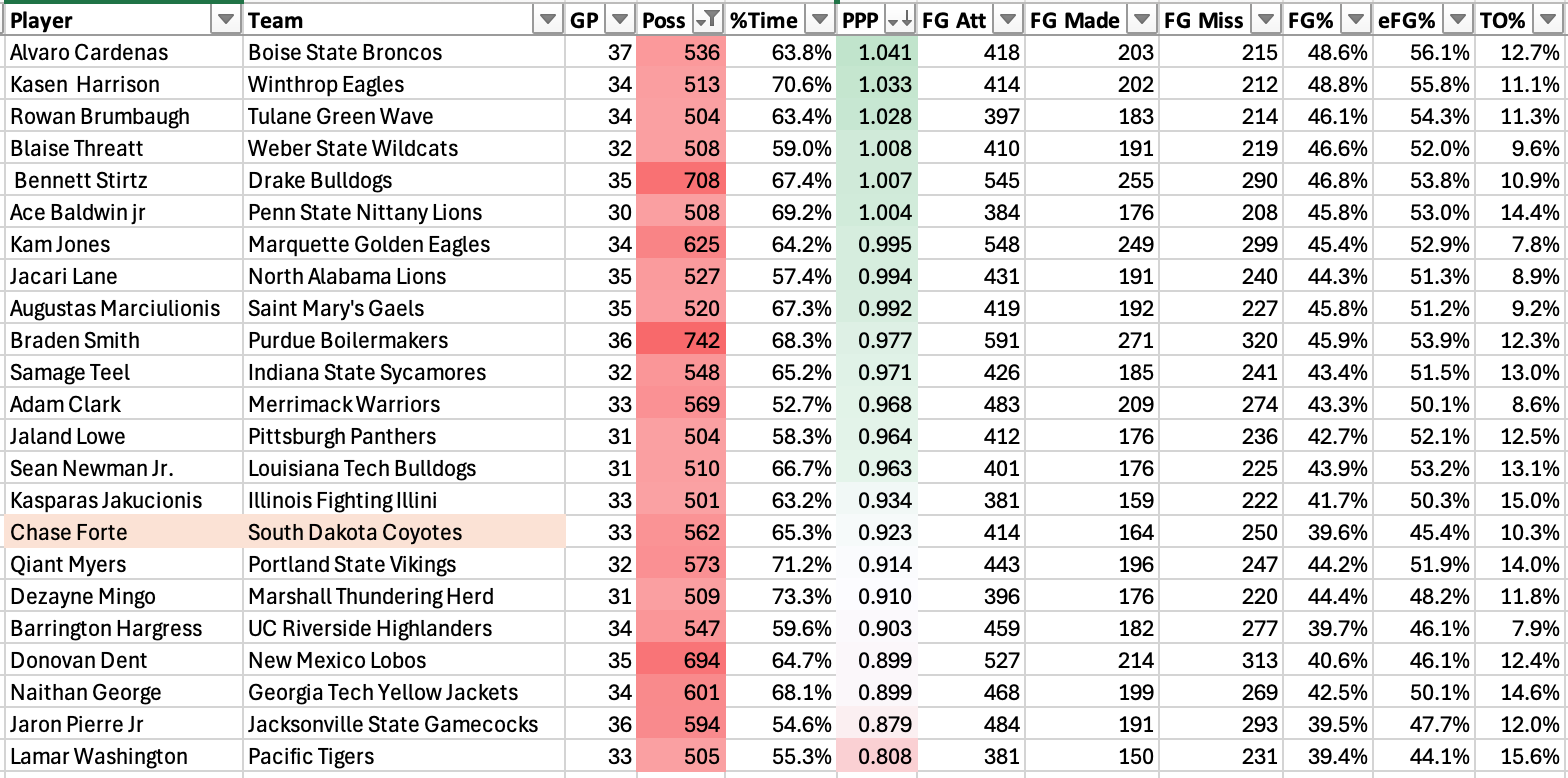
There's healthy skepticism as to how Forte’s game might translate to the ACC. Will his rim-thirsty attacking be effective against bigger frontlines? Or was it only effective against Summit League caliber defenders? For what it's worth, 17 of South Dakota’s games last year qualified as Quad 4 opponents.
Grant is willing to accept those risks because anything is an upgrade over last season. BC looked lost offensively without an on ball gravity bender to force help side defense. Additionally, Fred Payne and Donald Hand should benefit greatly from Forte’s rim pressure this season. Payne probably deserves to start this year but Grant might be better off deploying him as a sixth man, given his value is largely redundant with Forte and Hand. Plus, Payne is smaller than both Forte and Hand, who can really shoot it from distance.
Hand was money from 3-point range last year but his overall percentages were dragged down by forced, contested mid range pull ups out of necessity. He’s an effective driver when needed, but his bread and butter is catch and shoot jumpers, where he was FAR more efficient than shooting off the bounce.
On the other end of the floor, BC should be better defensively this year. Hand can be a liability guarding the ball at times, but inserting more length and size around him will help. Forte's Defensive Player of the Year hardware was buoyed by a gimmicky pressing system but he still spearheaded one of the most relentless pressing fronts in college basketball. The Eagles haven't disrupted anybody the last two seasons, so perhaps Forte can generate a couple of bonus steals a game to help boost this four factor category.
Hastings is the key as the backend anchor. He still needs to refine his positional intelligence and general awareness but he’s got the physical tools to be a plus rim protector in a featured role with more seasoning.
Causes for Concern:
It’s no secret BC has to make tradeoffs in its portal approach, as does any non blue blood program with constrained resources. As a result, the bench is a little young, unproven (and presumably cheap).
Luka Toews returns to the mix after playing precisely one good game all year last season - there may be brighter days ahead in his future but he’s still in the fetal stages of his development.
Big man Boden Kapke seems underqualified for a prominent role on a high major team but he was well regarded coming out of Minnesota - the Butler transfer poses a steadier, sturdier counter to Hastings at the 5.
Grant also inked three true freshmen from the high school ranks but the late pick up Marko Radunovic could be a surprise emergence in the core rotation. Our go-to international scouting expert Arman Jovic succinctly described his profiles as follows: “more of an upside guy then day one guy, but he probably gets rotation minutes. 6’7, good defender, high motor, solid athlete - just pretty raw skill wise.”
Despite facing headwinds in bringing in top tier talent, Grant, too, deserves some blame from a coaching perspective. Specifically, he’s been fairly criticized for ‘overadjusting’ and tinkering too frequently with lineup combinations over the course of the season, inhibiting any sort of consistent pecking order and role acceptance. Adaptability is important in this day and age but BC fans would love to see a more consistent rotation pecking order this season. This should iron itself pretty quickly given the chasm in talent between the top six and bottom six in this depth chart.
Bottom Line:
There’s cautious optimism around a BC bounce back this year but the ceiling is still relatively low, even with the swings at multiple high major talents with 4-star caliber pedigrees. The downside comes down to depth, a consistent limitation shared by the ACC cellar dwellers this year. This is a put up or shut up year for Grant and I admire his inertia bolstering the talent to try and level the playing field, but Grant himself has plenty to prove with the clipboard, too
16) Stanford
Key Returners:
Benny Gealer, Ryan Agarwal, Chisom Okpara, Aidan Cammann, Donavin Young
Key Losses:
Maxime Raynaud, Oziyah Sellers, Jaylen Blakes
Key Newcomers:
Jeremy Dent-Smith, AJ Rohosy
Roster:
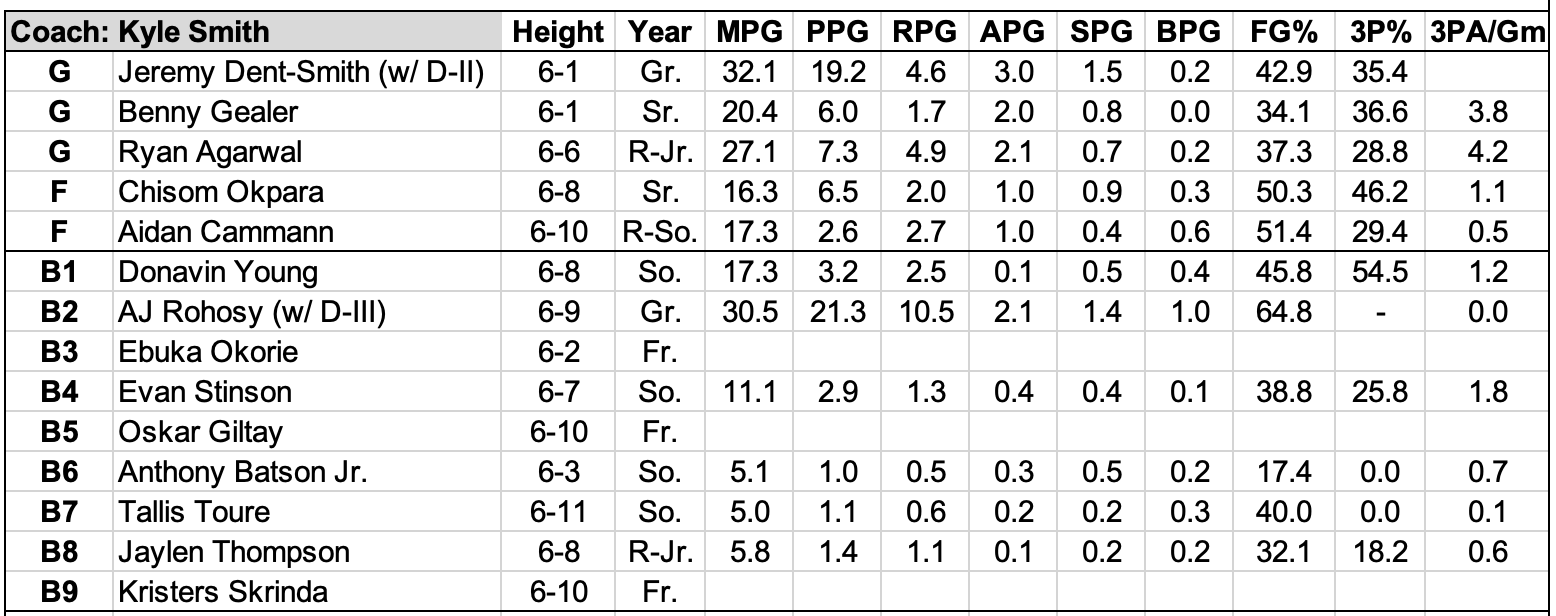
Reasons for Optimism:
One of the top D-II players in America is bringing his talents to Palo Alto to play for Kyle Smith.
In steps Jeremy Dent-Smith, a stocky 6-1 guard with next level shiftiness and big time shotmaking ability. He’s not crazy quick but he’s got a Jalen Brunson-esque change of pace to his game that allows him to get the separation he needs to get his shot off.
However, the secret sauce in ‘JDS’ repertoire might be the gravitational pull he has on defenders because he will pull up from anywhere, anytime. Per CBBAnalytics, Dent-Smith took over 27% of his shots last year from 25 feet or further, and canned a healthy 38.7% of those attempts.

He doesn’t need to barrel his way to the rim to score efficiently inside the arc, either. He drew a ton of fouls at the D-II level but he’s adept at finishing in the mid range as well, an adjustment that may be necessary in the ACC.
Dent-Smith may not be a prototypical point guard but his feel and instincts are ‘lead guard’ caliber. It seems inevitable that Kyle Smith hands him the keys to this offense as the prevailing perimeter creator, largely out of necessity.
The continuity around Dent-Smith is strong, including three established rotational pieces with multiple years of experience under their belt. Chisom Okpara is the most talented of the bunch, and now he has a clear stage to showcase his talents with Raynaud gone. Benny Gealer and Ryan Agarwal are the other two and they’re rare commodities as fourth year players with the same program. Gealer is the spot up sharpshooter while Agarwal brings a little more versatility to the table. Agarwal himself was once a lauded shooting prospect but that touch has evaded him the last two seasons. He’s still managed to make an impact as a playmaker and defender.
The depth looks strong when accounting for Donavin Young and Evan Stinson, two more returners with notable experience, along with Anthony Batson Jr. and Tallis Toure, a pair of second year wildcards with aspirations to see the floor more often this year.
Smith badly wants to retain and develop internally, so there’s a big bet on this rising sophomore class breaking out this season. Young is the one to add to the watchlist. He’s a bouncy forward with skill and fluidity to his game. If he can stay healthy, and hone his craft as a pick-n-pop floor stretcher, he might be the surprise emergent from this crop of underclassmen.
Behind the sophomores, Incoming rookies Oskar Giltay and Ebuka Okorie aren’t far behind their elder peers in terms of talent. However, the ace up Smith’s sleeve could be his former player from Washington State, AJ Rohosy, who Smith simply couldn’t find enough minutes for behind a vaunted frontline in Pullman.
Causes for Concern:
Losing big Max leaves a blank space at the 5 position, obviously. There are options in the pipeline but only Okpara is experienced, thus, Cammann and Toure may need to put their big boy pants on right away. If the Cardinal were loaded with 4-star and 5-star talent, the interior inexperience wouldn’t be as big of a concern but this roster skews more quantity over quality.
Smith will aim to mitigate his personnel limitations by changing defenses, as he’s done routinely over his coaching career. Last year, the Cardinal only played zone on 15% of their defensive possessions last year but qualifies as one of the top-50 highest zone rates in the country. Smith doesn’t want to rely on zone but rather use it as a strategic lever when needed. It was partly needed to keep Raynaud out of foul trouble last year, or protect him when he was nearing foul trouble.
A few of these younger, emerging frontline pieces bring an element of leaping verticality that Raynaud lacked, particularly Cammann, Young and Okpara. There’s no question this team is tall and long across the board but any defensive upside will come down to lineup usage.
There were times last year Stanford looked like a west coast version of Utah, another team with super long limbs but slow lateral agility. To avoid that pitfall, Smith should tap into these pockets of athleticism along the frontline, which might be the path to actually improving defensively this season.
Keep an eye on Cammann as a big part of this potential solution. He popped in spurts late in the season and ended up grading out as the clear best defender last season per EvanMiya’s DBPR metric:
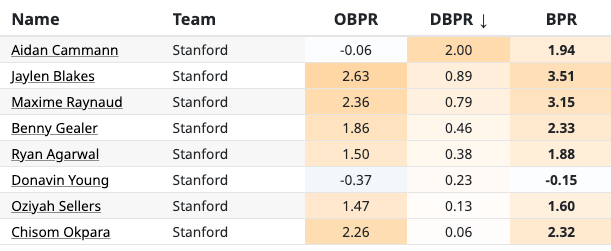
Bottom Line:
It’s wasted breath over-critiquing any roster limitations on a Kyle Smith coached ball club. The Godfather of ‘DataRaid’ has beaten his preseason KenPom ranking 13 of last 15 years, a remarkable streak of finding inefficiencies in both individual personnel talent evaluation and team level roster cohesion. Still, it’s likely the Cardinal wind up in the bottom half of the ACC leaderboard again but this flat league offers a ray of hope to make a more prominent move than I’m projecting here.
17) Georgia Tech
Key Returners:
Baye Ndongo, Jaeden Mustaf, Kowacie Reeves
Key Losses:
Naithan George, Duncan Powell, Lance Terry, Javian McCollum
Key Newcomers:
Lamar Washington, Mouhamed Sylla, Kam Craft, Chas Kelley III, Akai Fleming
Roster:
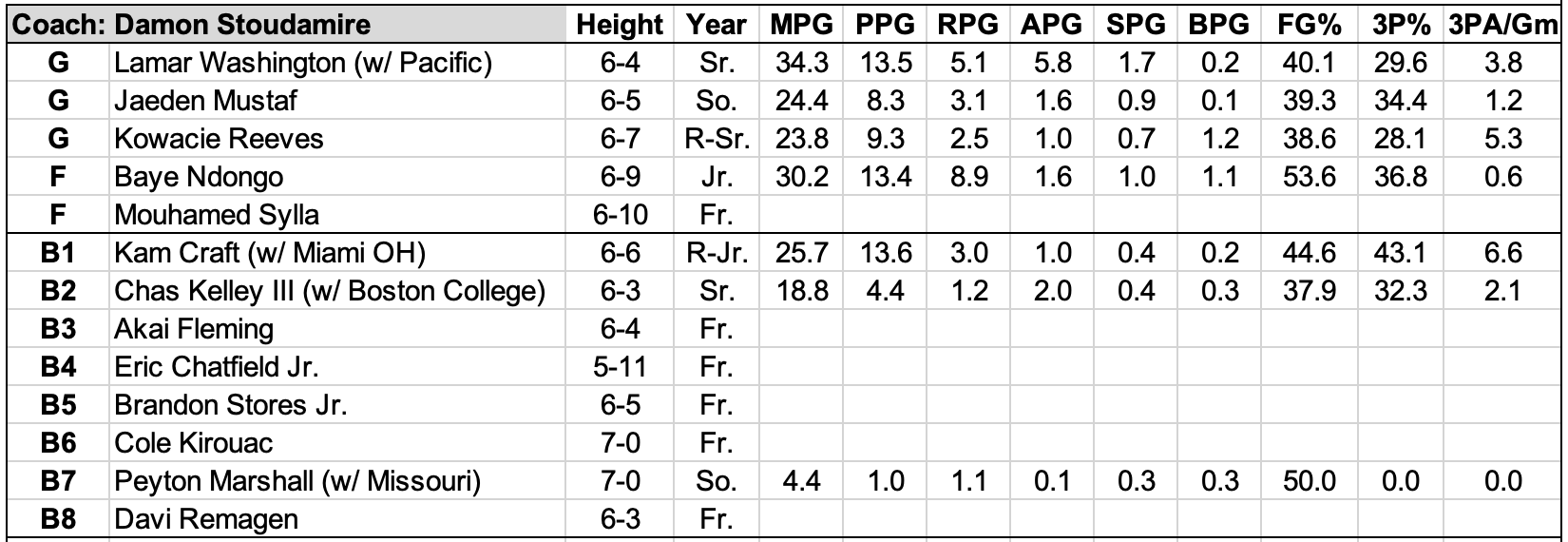
Reasons for Optimism:
It’s not worth overanalyzing last year’s blundered season, which was largely torpedoed by injuries up and down the roster. This revamped group is a harmonious blend of old and new, but the real firepower lies in the frontcourt.
The luster has worn off Baye Ndongo’s highly anticipated freshmen campaign but patience might be a virtue with Ndongo. Stoudamire admitted this summer he’s been too restrictive of Ndongo the last two seasons, and now wants to truly let the harness off. That could be good or bad, depending how much rope Ndongo takes from that liberty - we certainly don’t need Baye hoisting threes at a high clip. His athleticism and motor give him a high floor, in spite of his offensive finishing inconsistency, which makes him a walking double double in this league
Next to Ndongo is Mo Sylla, a freakishly scary rim protector with long term offensive upside to boot. In the near term, Sylla is probably just a rim running finisher but NBA scouts will have the microscope dialed on his loud defensive impact, which often turn into emphatic blocks that kickstart the fast break going the other way.
Kowacie Reeves, if healthy, is the Jackets’ X-Factor this season. Reeves has never been crazy efficient but his ‘3-and-D’ value is considerable on the wing. He proved he could make threes at a high clip two years ago (51/133 for 38%) and should be a big piece to this defensive puzzle.
The challenge for Stoudamire will be striking proper perimeter balance to create space and opportunities for the bigs to be effective inside. Reeves is just one building block to achieving that equilibrium. Jaeden Mustaf is the other notable wing returner with real upside. He struggled to stay on the floor last year but he just needs consistent reps, and a clear role. However, that could get muddied by some of the portal additions.
Stoudamire isn’t messing around with depth this year after the injury onslaught that riddled this rotation last year. He inked one of the most prolific shooters and shotmakers in the portal, Kam Craft, who found an oasis in Travis Steele’s modern offensive structure last season. The former Xavier product now returns to the high major pond to see if he can make good on his power conference pedigree. Again, Stoudamire is keen on creating more space for his bigs to operate inside, so floor stretchers like Craft are critical to that mission - though, Craft is far more dynamic than just a catch and shoot specialist.
On the other end, Craft may not be an elite defender but his positional size should help sustain GT’s sturdy defense as a unit. Mustaf (6-5) and projected point guard Lamar Washington (6-4) are plus sized guards at their positions, another notable trait of this retooled roster. Washington led the entire WCC in steal rate last season. No one on the roster stands shorter than 6-2, a clear indication of the NBA-esque positional size Stoudamire desires.
Up front, Sylla’s interior defensive upside is terrifying but Ndongo deserves credit for his defensive strides last year. He was pivotal to the Jackets’ improving their overall defensive efficiency from 148th to 73rd overall last year, which graded out as 5th best in the ACC. On paper, this defense looks better than last season.
Causes for Concern:
Perimeter shot creation is where the red flags lie. Stoudamire is a huge proponent of pick-n-roll basketball. For reference, one of every four offensive possessions was derived out of ball screen action, via the ball handler or roll man, per Synergy:
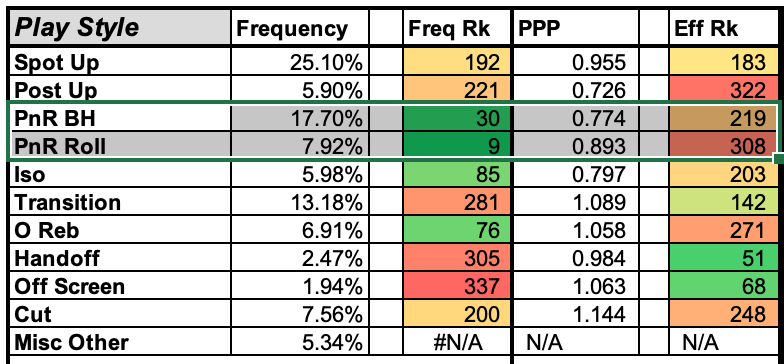
This is where Stoudamire is experimenting with a different lead guard prototype this season. Washington, who hails from Stoudamire’s backyard in Portland, is a jumbo sized lead guard, a major deviation from the Yellow Jackets’ quicker, smaller lead dogs the last couple of seasons.
Washington’s outstanding passing ability was constrained by a lackluster supporting cast last year at Pacific. Plus, he played virtually every minute of every game due to severe bench limitations. Washington does have a decent pull up middie in his bag to keep defenses honest if they over-sag but his first order of business should be to clean up the turnovers. BC transfer Chas Kelley III is likely no more than a backup, but he may be suitable in that smaller role, and Washington will welcome the breathers this season.
Washington is a polarizing case study this year but the larger question is how well Stoudamire’s pick-n-roll heavy offense fits with this roster, particularly Ndongo, who is not a sound decision maker as a roll man. Truth be told, the bulk of his damage is as a glorified garbage man on the glass, since his skill and explosiveness has yet to be harvested in an efficient form.
Stoudamire will need immediate production from his rookie class, which packs some serious perimeter punch on the perimeter.
Akai Fleming, a silky smooth shot maker and solid distributor, is the marquee name to remember. The hometown hero would likely be getting more coverage if injuries hadn’t derailed his ascendance. He might be the best pure shotmaker on the team, reminiscent of a taller Javian McCollum last season. There’s pockets of buzz around Eric Chatfield Jr. and Brandon Stores Jr. as well but Fleming is the one who pops on tape.
Bottom Line:
A bad bill of health downright ruined this team last season, so credit to Stoudamire for reconstructing a roster with more wiggle room for injuries. Granted, a big component of the improved depth this season is young, so time will tell how that holds up over the grind of the season.
Defense should be the Yellow Jackets' bedrock once again, a function of Stoudamire’s wise investments in positional size, especially amplified by the Cylla addition.
18) California
Key Returners:
DJ Campbell, Lee Dort, Rytis Petraitis
Key Losses:
Andrej Stojakovic, Jeremiah Wilkinson, B.J. Omot, Jovan Blacksher Jr.
Key Newcomers:
Dai Dai Ames, Chris Bell, John Camden, Justin Pippen, Milos Ilic, Nolan Dorsey, Jovani Ruff
Roster:
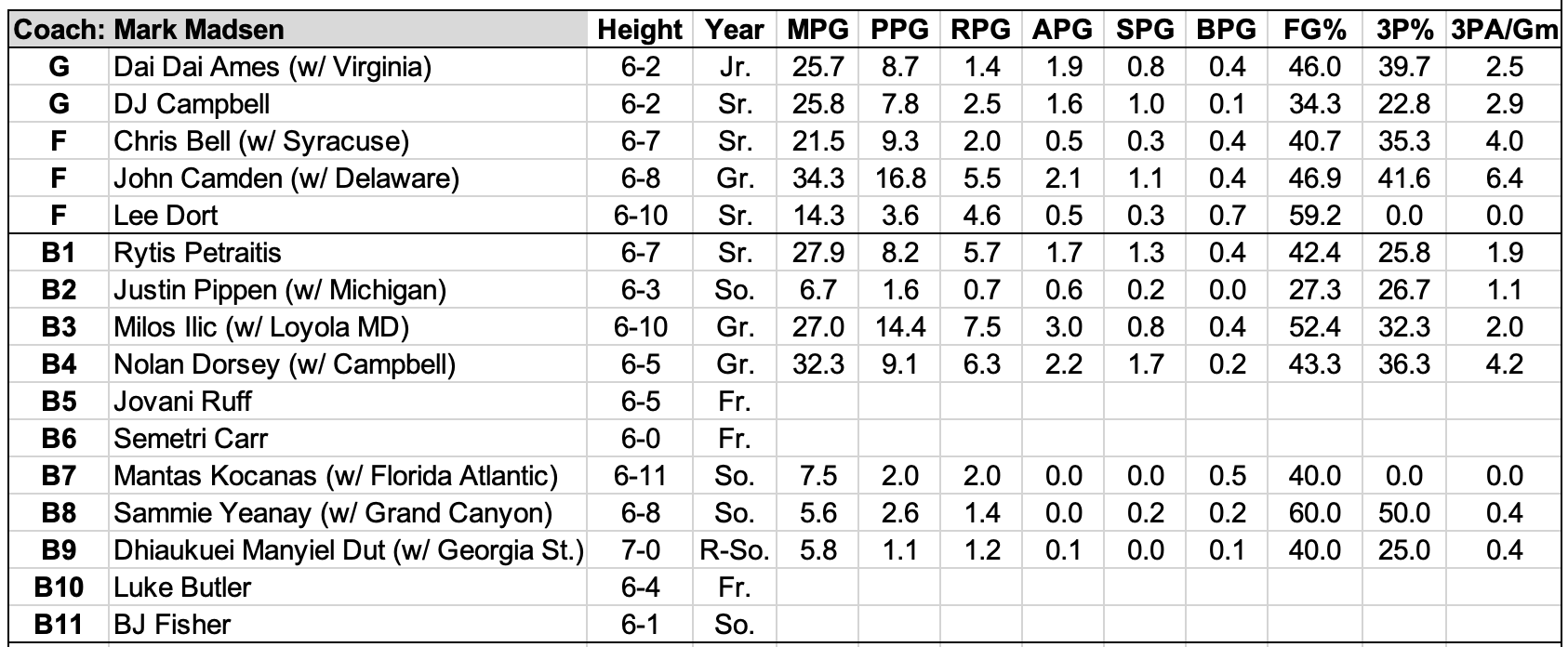
Reasons for Optimism:
It wasn’t a banner year by any stretch last season for Mark Madsen but he was also dealt a bad hand of poor shooting variance. The process didn’t match the results, according to ShotQuality.com’s expected offensive and defensive efficiency metrics.
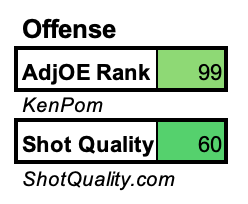
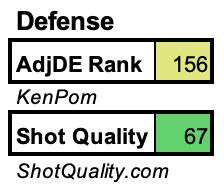
I’d probably reject the notion this was a top-60 ish team but Madsen’s Bears were certainly better than the 14-19 record showed. ACC opponents shot nearly 40% from behind the arc in conference matches last season, to go along with a league leading 78.5% from the free throw line. That’s just tough.
That doesn’t consider the injuries that festered all year long, or the strenuous west to east to west travel schedule, which made winning on the road feel like a Herculean achievement. The Bears won one game outside of the Pacific Time Zone last year, at NC State on January 18th.
Only three returners signed up for a ‘do-over’ but that continuity will feel like a blessing after last year’s complete roster overhaul.
DJ Campbell is the lone wolf returning in the backcourt. Ideally, water finds its level with his 3-point shooting, which dropped off a cliff last year - he went from a SoCon leading 48% clip in 2024 to 23% last season.
Up front, Lee Dort and Rytis Petraitis arm the Bears with a decent returning tandem. Dort, a former Vandy defector, proved to be a gargantuan upgrade to the interior defensive unit but he still doesn’t bring much to the table offensively. Petraitis can be a swiss army knife on that end with his vast array of tools - as discussed below, Madsen might consider redefining his role this year.
As far as portal priorities go, Madsen seems to put a premium on ball security. Such was the case last season, when Cal finished second in the ACC in offensive turnover rate, per KenPom - the horrendous shooting offset that decision making but Madsen was smart to not abandon that point of emphasis with his newcomers this cycle.
Schematically, I’m curious where Madsen goes with this roster. Last season, the Bears leaned on a pick-n-roll based attack but there wasn’t much ball movement off of that initial action. Losing Stojakovic and Wilkinson stings but perhaps replacing their minutes with better passers and connectors will help keep the ball moving. In essence, Cal was effective at taking care of the ball but the ball was stuck in one or two player's hands too often as well.
The depth at Madsen’s disposal should be a strength, especially when stacked up against the other bottom half ACC teams. Nine players have a serious case to start and / or play major minutes this season. The deep sleeper in this portal haul is Justin Pippen, a former top-100 recruit who couldn’t find the floor at Michigan. While most of the newcomers feel like lower ceiling, higher floor players, Pippen presents some potential upside if he can stick the landing.
Causes for Concern:
Pippen’s smooth scoring arsenal is one potential pathway to a more efficient offense in 2026 but there’s a host of other options for Madsen to call upon offensively. As a reminder, the goal here is to turn these horrifying red boxes into green ones.
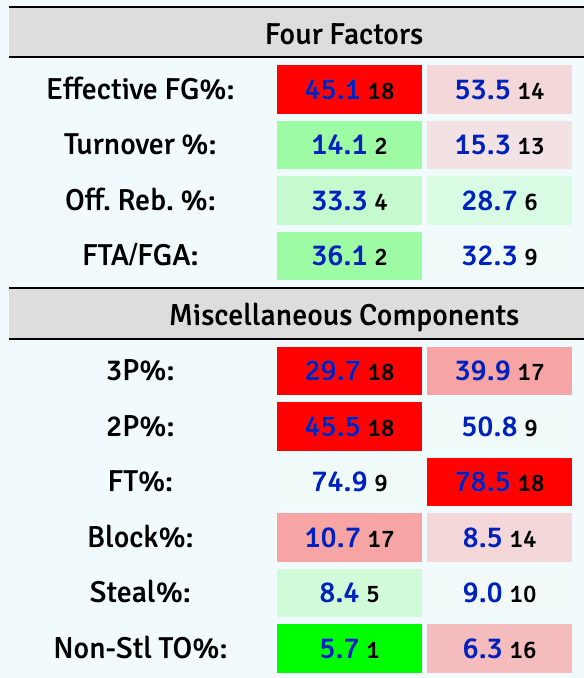
Virginia transfer Dai Dai Ames isn’t a pure point guard but he’s a willing passer and much improved. His percentages were strong from all three levels last season, and his skills may be elevated by a more modern offensive construct.
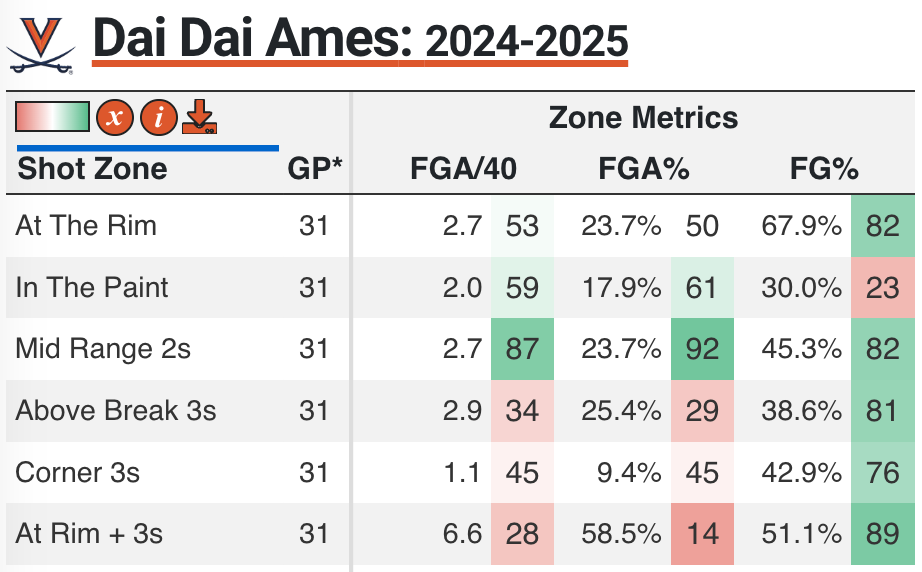
Ames, along with Pippen and Campbell, will need to assert themselves as proficient pick-n-roll initiators if Madsen wants to unlock the best version of John Camden. The sharpshooting 6’8 forward is a multi-level scorer with icy touch from all over the floor. He can be a lethal pick-n-pop driller, or short roll driver in ball screen action.
Syracuse sharpshooter Chris Bell will likely flank Camden on the wing. Bell looks the part of a vintage ‘3-and-D’ wing but that speaks to his limitation as a shot creator on offense - for reference, 70% of his field goals last year were assisted on last year, and the most assists he recorded in any game last season was…. 2!
The critical tool in Camden’s bag is his vision, which illuminates a potential solution to the Bears’ lackluster perimeter playmaking: generating shots from the inside-out, specifically with Camden, Petraitis or Milos Illic, an effective big man passer well schooled in inverted Princeton passing principles.
The same is true for Petraitis, who was a dime dropping machine during his dominant days at Air Force. Last season, Madsen couldn’t put Petraitis to good use as a complementary piece, as his assist rate dropped off a cliff from his first two years in Colorado Springs.
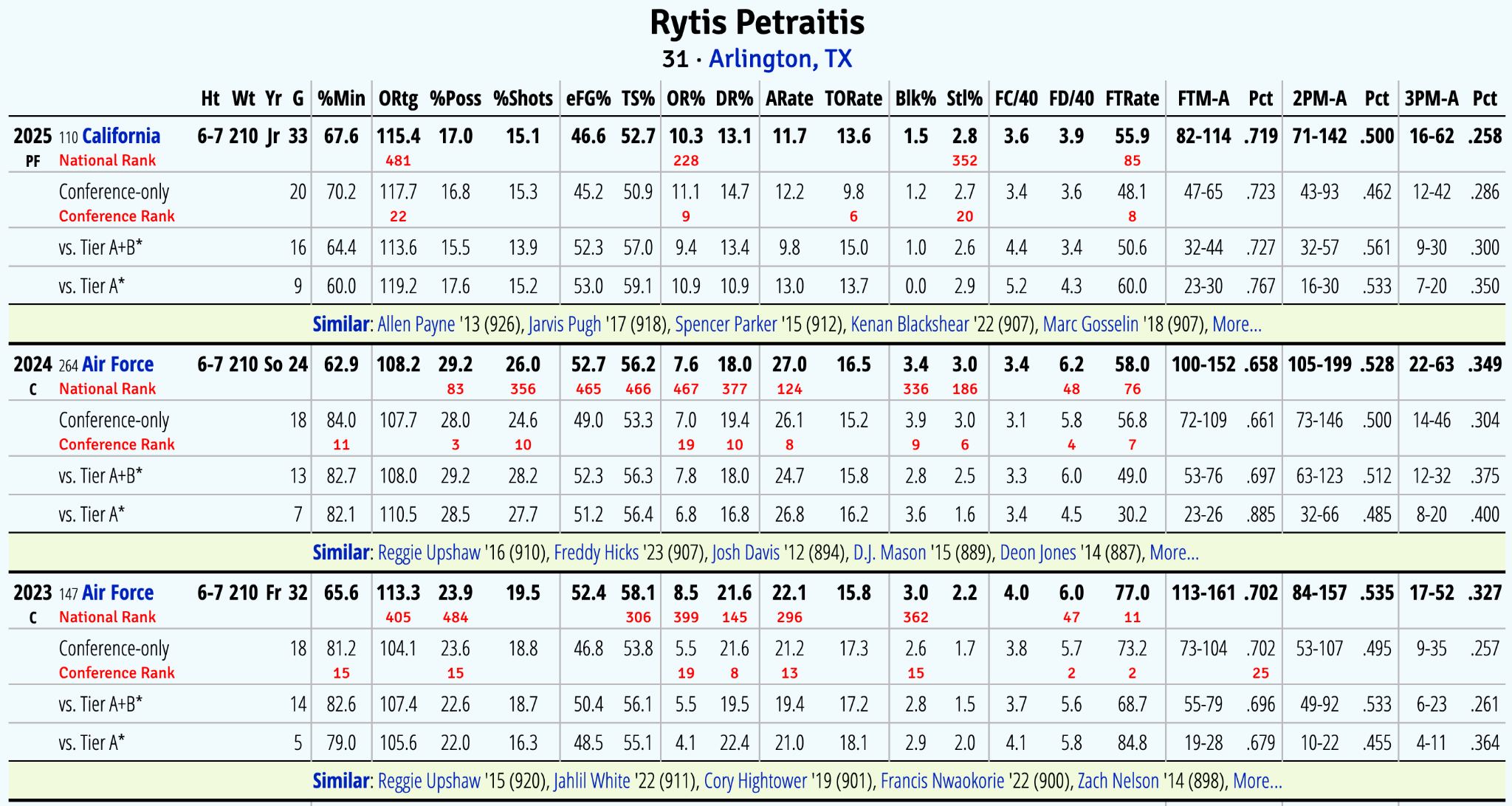
On the other end, Cal may struggle to guard the ball again this season. The Bears' inability to contain dribble penetration damaged its defensive shell. Historically, Madsen has been a big proponent of running shooters off the 3-point line but the Bears’ extended perimeter coverage was consistently exposed by simple ball screens.
Adding a perimeter stopper such as Nolan Dorsey, the reigning CAA Defensive Player of the Year, could be a revelation in this domain. It’s hard to see how he doesn’t play starter minutes if the Bears' defense continues to leak on the perimeter.
Bottom Line:
With Cal’s strong academic brand name, one would think this program could retain younger players, akin to Stanford or the other Ivies on the East Coast. It’s a shame Stojakovic and Wilkinson bolted for greener pastures, but perhaps their absences will be a blessing in disguise, assuming Madsen can push the right buttons with this deep and somewhat unorthodox roster.
All in all, Madsen is betting on age, experience and depth to overcome the lack of top end star power. The ACC is flatter than ever, so Cal could easily climb closer to the top-10 if all breaks right - consider this last place selection proper bulletin board material, as I fear this may be one of my bigger regrets of all 18 team projections.

